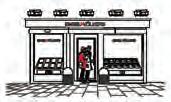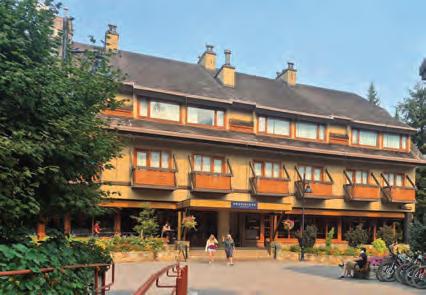

Lest we forget
HORROR SHOW Little Shop of Horrors premieres at the Maury Young Arts Centre

















Lest We Forget
Remembrance Day ceremony returns to Whistler in wake of Invictus Games. - By David Song
06 OPENING REMARKS Despite the Toronto Blue Jays’ heartbreaking Game 7 World Series loss, there’s a lot to love about this year’s team, writes editor Braden Dupuis.
08 LETTERS TO THE EDITOR This week’s letter-writers call for more support for Whistler’s aging population, and share thanks for another successful Halloween in Tapley’s Farm.
24 THE OUTSIDER There’s a battery in just about everything these days, writes Vince Shuley—but which ones belong in the outdoors?
46 PIQUE’N YER INTEREST As we continually choose to use AI over the real thing, it’s easy to forget what we’re not choosing, writes Lizi McLoughlin.
COVER - ByJon Parris // @jon.parris.art
Publisher SARAH STROTHER - sstrother@piquenewsmagazine.com
Editor BRADEN DUPUIS - bdupuis@piquenewsmagazine.com
Sales Manager SUSAN HUTCHINSON - shutchinson@piquenewsmagazine.com
Production Manager AMIR SHAHRESTANI - ashahrestani@piquenewsmagazine.com
Art Director JON PARRIS - jparris@piquenewsmagazine.com
Advertising Representatives
TESSA SWEENEY - tsweeney@wplpmedia.com
ANDREW BUDRESKI - abudreski@piquenewsmagazine.com
Digital/Sales Coordinator KATIE DOUGLAS - kbechtel@wplpmedia.com
Reporters
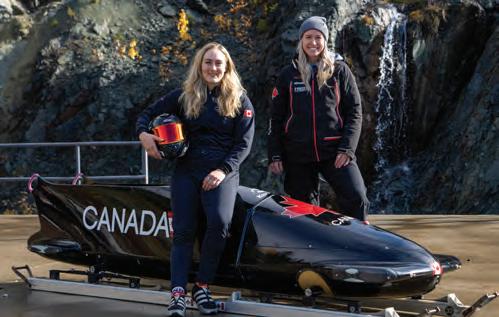

10 TOO DAMN HIGH A new renters union aims to give renters in Whistler a seat at the decision-making table.
11 BUDGET SEASON The public portion of Whistler’s 2026 budget process is officially underway, with plenty of opportunities for locals to weigh in.
30 AROUND THE BEND Canada’s bobsled team is facing funding challenges as it slides towards the 2026 Olympics in Italy.
34 HORROR SHOW The Pemberton Arts Council presents Little Shop of Horrors at the Maury Young Arts Centre on Nov. 21.
LUKE FAULKS - lfaulks@piquenewsmagazine.com
DAVID SONG - sports@piquenewsmagazine.com
Office Manager HEIDI RODE - hrode@wplpmedia.com
Classifieds and Reception - mail@piquenewsmagazine.com
Contributors G.D. MAXWELL, VINCE SHULEY, LESLIE ANTHONY, GLENDA BARTOSH, ANDREW MITCHELL, LISA RICHARDSON, LIZI MCLOUGHLIN, TOBIAS C. VAN VEEN
Founding Publishers KATHY & BOB BARNETT www.piquenewsmagazine.com













How can you not be romantic about baseball?
I HAVEN’T ALWAYS been a baseball fan.
As a callous, loose-cannon of a sports writer in my university days, I once published an expletive-filled rant against the sport— which actually included the uncensored

BY BRADEN DUPUIS
phrase “f*** you, baseball”—in the weekly sports roundtable of our student paper, which inspired my first-ever piece of legitimate hate mail from a reader (but not the last!).
And at the time, being so young and edgy and sure of myself, I actually meant it when I wrote the words “take your over-paid, boringass, no-contact sport and shove it up your ass.”
But time has a calming effect on a man. It softens those blunt edges; nourishes the soul with a little more humility and hard-won wisdom with each passing year.
And maybe that rant was mostly the product of another tough week in my punishing journalism program. Either way, soon I was only indifferent to baseball. Then, respectful from a distance. By 2015 I was bandwagoning the Jays in the postseason with most of Canada.
But it wasn’t until 2022 that I finally “got” it. And I’ll never forget the time or place I had my “come-to-baseball moment,” as I now describe it.
It was at my sister’s house in Sylvan Lake, on my first vacation after becoming editor of Pique—the first deadline Tuesday in many, many months that I wasn’t rushing to edit stories, letters, sort photos and cutlines, stressing endlessly about this and that and everything. The first Tuesday in months that I had nothing to do but sit.
And so there I was, sitting. My sister and her husband had taken their boys to the park, and the Blue Jays game was on. I watched.
And less than five minutes in, it all just clicked, like the game had been waiting for me to understand its grammar; like realizing every movement had always been part of a larger plan.
A literal game of inches; of eternally evolving strategy—whether one-on-one and team-against-team, or a managerial battle of wits and insider knowledge. Each pitch presenting a different scenario depending on the score, the inning, who is on base and who is at the plate, who is on deck and who you’ve got waiting in the bullpen.
I was instantly hooked. From that moment on, I was quite literally obsessed with baseball and the Toronto Blue Jays, watching every single game I could.
Earlier this year, I made my first pilgrimage to Toronto to watch them live and in person,
favoured in most instances. Improbably, they secured the AL East division in the final game of the regular season—a game I listened to in its entirety on the radio while driving from Rosetown, Sask., to Sylvan Lake, AB., (coincidentally, back to my sister’s).
And then, that magical run to the World Series. Disposing of the storied New York Yankees in four games, on the back of a Vladimir Guerrero Jr. grand slam and the pitching heroics of 22-year-old Trey Yesavage. The psychotic fury of “Mad” Max Scherzer on the mound, and the improbable George Springer home run in Game 7 against the Seattle Mariners that was instantly imprinted on an entire country’s consciousness. The timely magic of down-lineup role players like Ernie Clement, Addison Barger, Davis Schneider.
There are too many instantly iconic moments to even list. Whether you’re a longtime fan, a recent convert like myself, or
6 and 7 against the Dodgers, which had their own share of moments we’d all rather forget. A lodged ball, and a blown spot of base-running; an out at home plate caused by a poor lead-off at third, a direct result of the aforementioned blown spot; a big catch at the warning track; a broken bat in the worst possible moment.
A literal game of inches. Of timely heroics or instant heartbreak. No telling which you’ll get, and when.
“The only thing I can think of right now is spending this last night with all the boys. I’m just going to miss them in the off-season. I couldn’t wait to come to the field every day and just hang with everybody,” an emotional Clement said in the wake of that devastating Game 7 loss. “I’ve been crying for probably an hour. I thought I was done with the tears, but I just love these guys so much. It was just so much fun coming to work every day and battling with these guys. We have so much to be proud of, even if it didn’t go our way.”
“I’ve been crying for probably an hour. I thought I was done with the tears, but I just love these guys so much. It was just so much fun coming to work every day and battling with these guys. We have so much to be proud of...”
- ERNIE CLEMENT
catching three games in three days against the Detroit Tigers, which only furthered my infatuation with the game. At that point the Jays were off to a middling start, floating somewhere around a .500 record. But shortly after that, something magical happened.
Our boys went on an absolute tear. From that point of the season they won far more than they lost, conquered rivals the experts
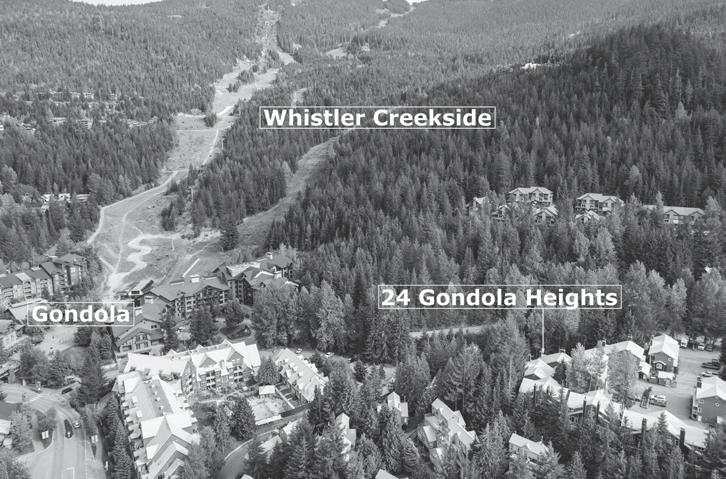
Updated2-bed, 1.5-bath,1140sq feet townhousewith Whistler Mountain views. Featuresopenlayoutwith stainlesssteelappliances, granite counters& cozy woodfireplace, plusspaciouslower-levelden. Prime Creeksidelocation-steps to gondola, shops&trails.Unlimited owner usewithnightly&long-term rental options.GSTnotapplicable. Askingprice-$1,399,000 24-2211 MarmotPlace
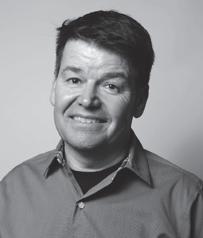
one of many who joined the bandwagon for this historic run to the finals, we have all just witnessed something exceptionally rare and, yes, magical. Even if it’s just, as Yesavage put it recently, a “children’s game” played by “fiveyear-olds.”
And it’s those aforementioned moments that should stand the test of time, as opposed to the utterly heartbreaking finale in Games
This from a guy who was once an afterthought, before going on to record 30 hits in the 2025 postseason—a Major League Baseball record.
How can you not love this team?
And as Brad Pitt’s Billy Beane so eloquently phrased it in the Oscar-nominated 2011 film Moneyball—how can you not be romantic about baseball? n












Whistler needs to do more to support its aging population
To start, l need to thank everyone that was involved with, or came out to, the “Rock For Big Kev” fundraiser at Merlin’s on May 2. That was definitely proof of the heart of Tiny Town, and was one of the best parties thrown in town in a while.
I celebrated my 20th anniversary being a Whistler resident on Oct. 10. A few friends packed my belongings into a U-Haul on Oct. 20, and my tenure in Whistler came to an end. But it wasn’t the usual story of affordability that drove me away. Instead, it was Whistler’s lack of medical supports for an aging population. Back on May 13, (not even two weeks after the fundraiser), I had a stroke. No face-drooping, no noticeable slurring, no headache, no noticeable weakness on one side (the weakness was hidden by the symptoms of Multiple Sclerosis).
I had fallen and couldn’t get up. A trip with paramedics to the Health Unit ER Department didn’t reveal anything. It was thought to be just the MS flaring up, so after six hours hanging out in the ER, they sent me home. The next morning though, I fell down again, and once again couldn’t get up. Paramedics brought me back to the Whistler ER, and this time the slurring was a little more noticeable. They sent

me down to Lions Gate Hospital (LGH), and after countless tests, they determined l had indeed suffered a stroke.
I’ve been in LGH ever since, doing rehab therapy, and waiting for an assisted-living space in Squamish’s Shannon Falls (SF) since August. SF is on Third Street, behind the Chieftain Centre (Sobeys/Shoppers Drug Mart). It is Vancouver Coastal Health’s only assisted-living facility in the Sea to Sky. Whistler has no supports for aging in place. Home Care and Home Support, as wonderful as
they are, are limited in the assistance they can provide. Unless you’ve got family helping you, there’s nothing to help you stay here.
Having hosted the Paralympics in 2010, you’d think Whistler would be more inviting to keeping long-term residents with health concerns. Whistler is celebrating just 50 years as a Resort Municipality. There hasn’t been much time to think about aging in place. As a town, it’s very youthful, and as such, doesn’t push an older agenda. Those that have been here a long time are being forced out because there isn’t
the supports needed for aging in place. Affordability isn’t the only issue facing Whistler. As more and more of Whistler’s population ages, they’re being forced out because there isn’t anything to help them age in place. It would be nice to see more thought put towards this issue before Whistler loses more of its aging population.
Kevin “Big Kev” Mikkelsen // No fixed address
Thank you from Tapley’s Neighbourhood Halloween
Thank you to everyone who took part in the 42nd annual Tapley’s Halloween festivities. Not even the rain or Game 7 of the World Series kept trick-or-treaters away. Our wonderful neighbourhood once again pulled out all stops from the artistically carved pumpkins to the themed houses and fabulous costumes with 53 neighbours participating. We welcomed more than 1,000 local children and parents to trick or treat on a damp and chilly night. It was encouraging to see so many kids and families dressed up, and that we were able to gather to celebrate Whistler’s longest-standing community tradition.
We greatly appreciate the generous candy donations from Nesters Market, Your Independent Grocer, Creekside Market, the Grocery Store, and Fresh St. Market, which enabled us to provide 350 pieces to each household this year. We collected more than 16,000 pieces of candy through local




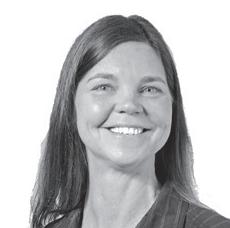


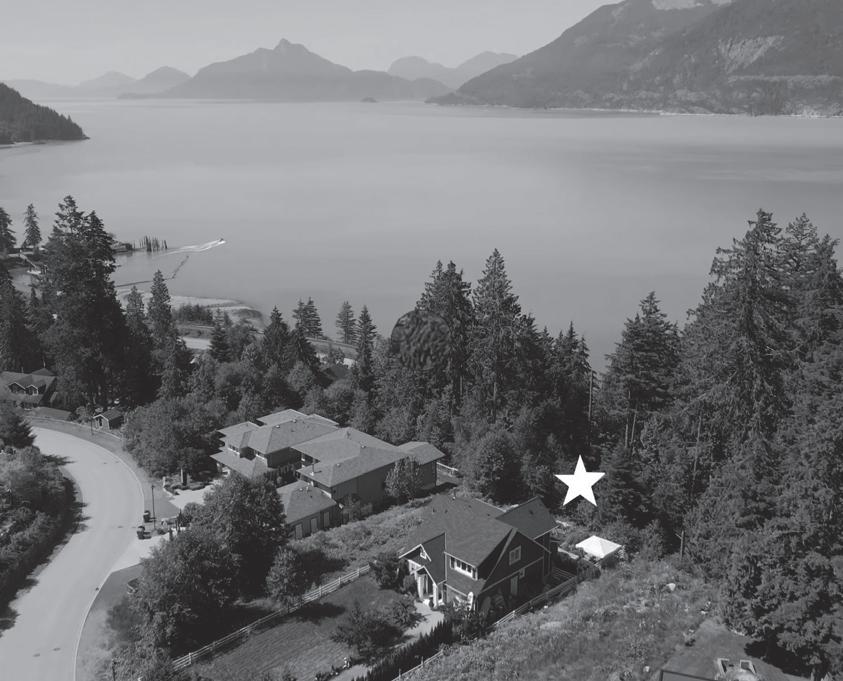

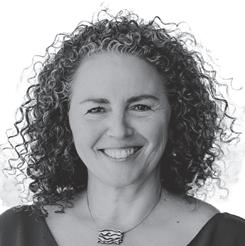
donations and estimate that more than 40,000 pieces were distributed as neighbours always generously enhance donations to meet the demand. Thanks to everyone who donated at our collection boxes around town as well as the support of Myrtle Philip Community School, Spring Creek Community School, Waldorf, Whistler Children’s Centre and Teddy Bear Daycare.
A big shout-out to Bruce Stewart and Nesters Market for their continued sponsorship
LETTERS TO THE EDITOR
Foundation for the Small Neighbourhood Grant to support the entrance and Whistler Balloon Works for the display.
Thank you to the Whistler Secondary School Leadership Team and the 20 enthusiastic student volunteers coordinated by vice principal John Hall for manning the entrance and supporting our “We Scare Hunger” campaign. Together, we raised $2,644 in cash donations and 115 kg of non-perishable food donations for the Whistler Food Bank, which
“Having hosted the Paralympics in 2010, you’d think Whistler would be more inviting to keeping long-term residents with health concerns.”
- KEVIN MIKKELSEN
of the spectacular fireworks display and hot chocolate. Special thanks to the Whistler Fire Rescue Service and its members for safely igniting the spectacular fireworks show and handing out hot chocolate, to the RCMP officers for their ongoing support, and to BC Transit, Whistler Marketplace, FastPark and the Resort Municipality of Whistler for organizing the free parking and shuttle, and to Whistler Waldorf School for decorating the bus. Also thanks to Pique Newsmagazine, Mountain FM and IHost for your generous promotional support. A huge thank you to the Whistler Community
were gratefully received by Whistler Community Services Society.
Thanks to our amazing Tapley’s volunteers including Sue Hargrave, Ilesa McAuliffe, Dianne Foster, Jordan Kobelka and Christine Dennstedt, and all of our amazing neighbours for supporting Whistler’s longest-running free event year after year.
Our Whistler spirit is alive and well in Tapley’s neighbourhood! See you next year for our 43rd edition!
Amanda Wilson & Shauna Hardy // On behalf of Tapley’s neighbourhood n

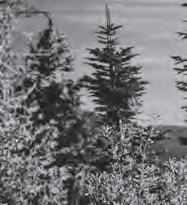

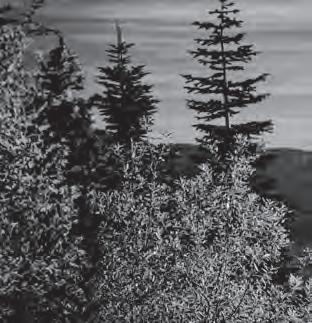







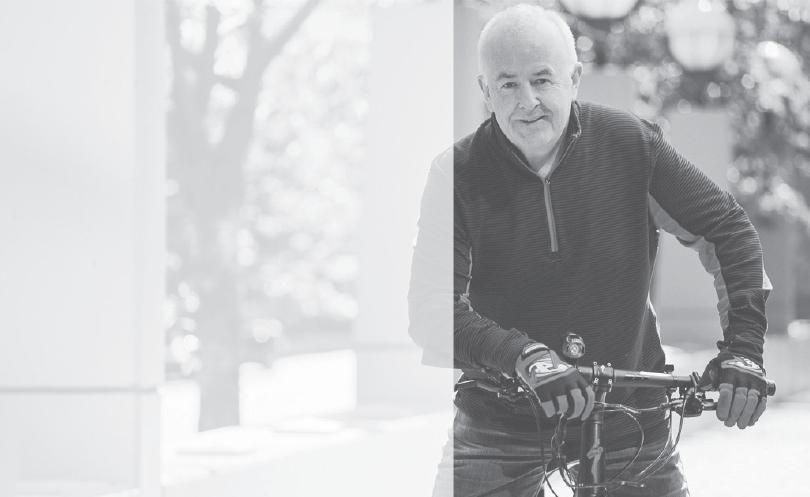
NickDavies, Whistlerlocal andexperiencedfamilylawyer practisingacrossBCandYukon. Callat 604-602-9000 or visit www.macleanlaw.ca
MacleanLawisheadquartered inVancouverwithofficesacross BritishColumbia.

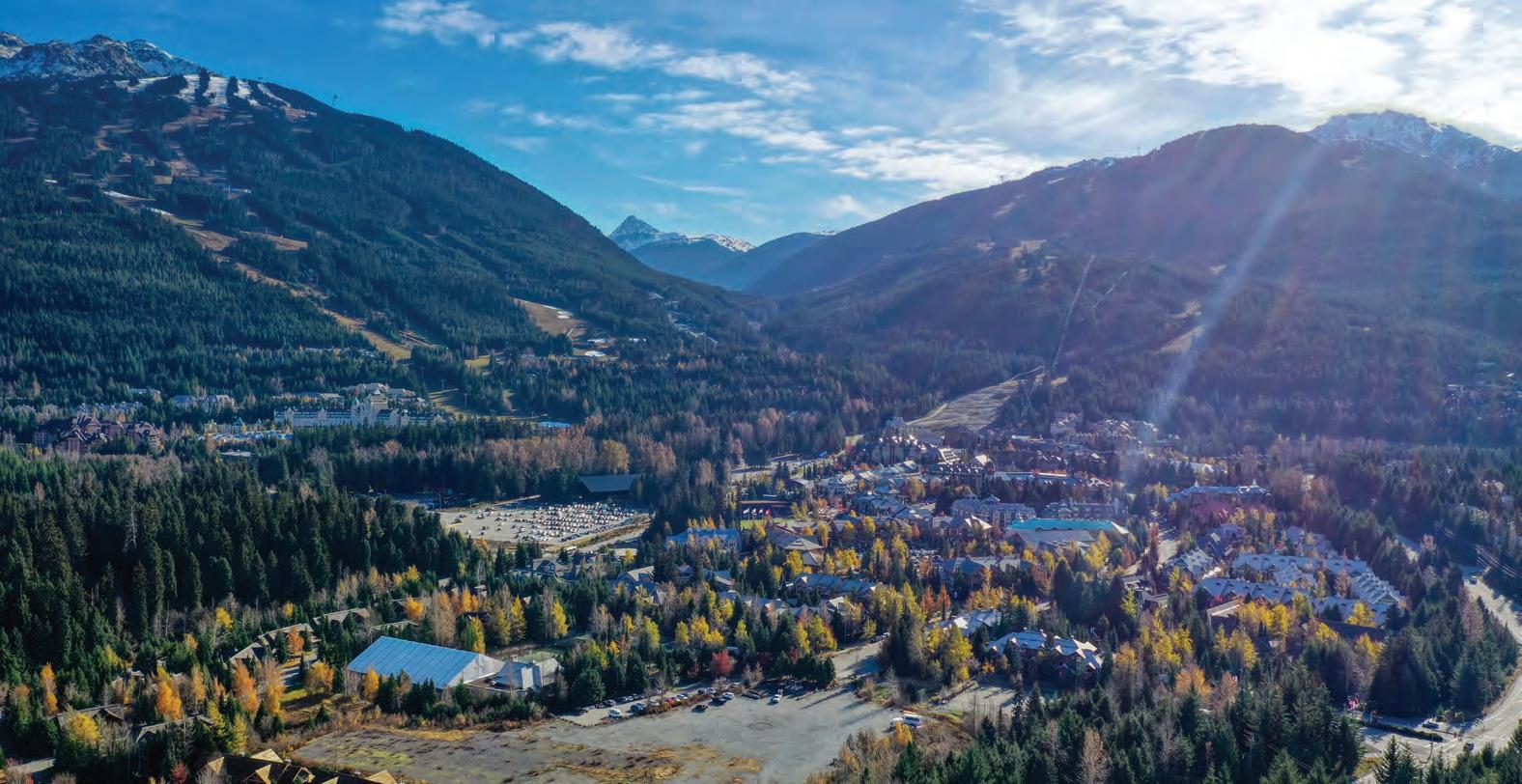
Renters unite: New Whistler union aims to give voice to the 44%
‘THIS TOWN CAN BE A LITTLE PREDATORY FROM THE LANDLORD POINT OF VIEW. NEW RENTERS SHOULD KNOW THEIR RIGHTS,’ SAYS
FOUNDER SEAN FOSTER
BY LUKE FAULKS
Local Journalism Initiative Reporter
WHEN SEAN FOSTER moved to Whistler a year and a half ago, many conversations he had about renting came with a horror story attached.
“Almost every other renter that I talked to in town seems to have gone through some sort of nightmare,” he said. “Whether it’s with their landlord or finding housing, everyone’s got one.”
Those frustrations, and what he describes as an absence of renter representation in local politics, led Foster to found the Whistler Accommodation Renters Union (WARU) earlier this fall.
“Forty-four per cent of the town are renters, and I kind of saw a need to get organized,” he explained.
A web designer and marketing professional by trade, Foster built WARU’s website (whistlerrentersunion.org) himself and began recruiting members. The group aims to advocate for tenants’ rights, provide education about B.C. tenancy law, and lobby for policy change at the municipal level.
Mayor Jack Crompton said he welcomes the creation of groups like WARU, calling renters “core to who Whistler is and who we’re becoming.
“People who are raising the need for housing in this community are doing good work,” he said. “It would be great if his work ended up realizing more people as part of our public process.”
HOUSING GAP
The scale of Whistler’s housing challenge is significant.
According to the Resort Municipality of Whistler’s (RMOW) Interim Housing Needs Report (released in December 2024), the community will need 1,572 new homes within five years, and more than 5,600 units over the next two decades to meet current and projected demand.
Of those, nearly 900 units are required just to keep up with household growth over the next five years, while more than 175 are needed to address “suppressed household formation”—young people or families unable to form households because of a constrained rental market.
“They’re not building fast enough,” said Foster.
Crompton defended Whistler’s record on housing, noting the Whistler Development Corporation and Whistler Housing Authority are “under construction on $100 million of rental housing.
“The case may be that that’s not enough, and certainly we will do more as we move
forward,” he said. “But $100 million under construction is nothing to minimize.”
ANOTHER VOICE IN THE RACKET CLUB DEBATE
WARU’s first campaign zeroes in on the 4500 Northlands redevelopment, where the union is calling for 70 per cent of the project’s $47 million Community Amenity Contribution (CAC) to be locked in by covenant for new employee housing.
“The idea that property owners are going to get a new gym or a seniors’ centre during a housing crisis, when people are raising toddlers in studios, is ridiculous,” Foster said.
WARU’s official statement frames the stakes starkly: “We’re asking council to strike a deal that makes sense as soon as possible and guarantee delivery [of housing] within the next five to 10 years. Whistler renters cannot afford this lot to sit empty for another decade.”
The mayor said the municipality has not yet decided how to allocate the Community Amenity Contribution (CAC) from the redevelopment.
“It’s certainly a big number,” he noted, adding that residents—including renters— will have the chance to weigh in. “The decision around the CAC for Northlands has not been made yet, so we’re encouraging people to participate,” he said. “It would be wonderful if renters and everyone would participate in the survey … and in the public process when we start making decisions in the new year.”
A survey on the Northlands’ CAC is available on Engage Whistler until Nov. 16.
MOBILIZING A RENTER VOICE
Foster said WARU is designed to “counter” the organizational power of property owners’ groups.
“They’re collecting rents while we’re working two jobs,” he said. “They have money, they have lawyers, they’re very organized. Our goal is to counter that with an equal force.”
To build momentum, WARU plans a public outreach push—on Reddit, Instagram and in person.
“I might even stand on the Stroll with a sign,” Foster said. “One of the best ways to get authentic members is looking someone in the eye and listening to their story.”
Crompton noted the RMOW has become increasingly creative with how it engages with the public to try to get those voices in the door.
“If we’re going to hear the voices of renters, if we’re going to hear the voices of people who are not typically engaged, it’s going to be because we’ve been proactive and we have been creative,” Crompton said.
That creativity, RMOW staff said, extends across several new initiatives. Add Your Voice, for instance, is a “trade show–style” engagement event that brings multiple projects under one roof, allowing residents who show up to learn about one topic to
‘Doing a bit less with the same’: Policing, fire and transit dominate
Whistler 2026 budget talks
RMOW EYES 8-TO-9% TAX HIKE AS COUNCIL CONSIDERS SMALL CUTS IN RECREATION, TRANSIT AND CULTURAL PROGRAMMING
BY LUKE FAULKS
Local Journalism Initiative Reporter
WHISTLER COUNCIL BEGAN its review of the Resort Municipality of Whistler’s (RMOW) draft 2026 operating budget during a Nov. 4 Committee of the Whole meeting, with staff warning of significant upcoming cost pressures tied to policing, fire and transit.
This year, the RMOW is proposing a budget that sees an eight- to nine-per-cent property-tax increase next year, alongside utility rate hikes of nine per cent for water, 10 per cent for sewer and three per cent for solid waste.
Staff said Whistler’s financial planning is occurring against a national backdrop of fiscal constraint. Municipalities across Canada receive only eight to 10 cents of every tax dollar while assuming growing responsibilities for housing, infrastructure and climate adaptation.
“The RMOW continues to constrain spending on standard municipal services while seeking opportunities to expand and diversify revenue,” the draft budget report states. Those measures include increasing user fees, adjusting parking and facility rates and pursuing grants from senior levels of government.
THE THREE BIG ROCKS
The budget identifies three key areas— policing, fire, and transit—expected to have the largest impact on the municipality over the next three years.
“They’re called big rocks because they need to fit into the budget jar and everything else needs to move and to fit around these items,” staff explained. “So each of them
also offer feedback on others. The Cents and Sensibility Budget Quiz Night takes that further, targeting a younger crowd in a pub setting where participants can learn about next year’s budget, win prizes and pose questions directly to staff and council.
At the upcoming Return to Winter event on Dec. 1, staff will host a booth to introduce returning Whistler Blackcomb employees to ongoing projects and show how they can get involved, even if they aren’t eligible to vote.
BARRIERS AND NEXT STEPS
Whistler’s transient workforce and high turnover have undermined previous organizing efforts.
“That’s why the last one fell apart; it just lost interest,” Foster said. “The transient nature is going to be a hurdle here.” Still, he believes WARU can endure by connecting renters’ stories to policy action and supporting
helps us catch up to the size and shape of our community and puts public safety and climate goals at the top of the priority list.”
The first is the Whistler Fire Rescue Service, where council’s 2024 decision to fully staff Fire Hall No. 3 in Spring Creek will require permanent funding. The second is the RCMP contract; once Whistler’s population exceeds 15,000 in the census, its local cost share grows from 70 to 90 per cent. The third is transit, as provincial COVID-era “Safe Restart” grants end and service hours expand by 6,000 next year.
“They’re called big rocks because they need to fit into the budget jar...”
- RMOW STAFF
Together, the three big rocks are projected to raise taxpayer-funded costs from $12 million in 2023 to $23.6 million in 2028.
The RMOW is “smoothing” the tax increase to pay for these big rocks. Absent the smoothing, staff note tax increases around those big-ticket items would be far more variable, from 2.2 per cent in 2026 to 7.4 per cent in 2027.
“With the smoothing exercise, [we’re] facing two more years beyond this one of nineto 10-per-cent tax increases in order to land at a place in 2028 where we are appropriately




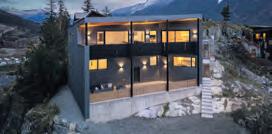


members directly.
“We’re going to help people on an individual basis, and then we’re going to have their stories to leverage against the mayor and council,” he said.
In the meantime, WARU’s immediate goals are clear: secure a binding housing commitment for housing funds from the Northlands CAC, push for rezoning of Blueberry to allow more residential units and establish a renter orientation program for newcomers.
“So many landlords in this town get away with murder just because the tenant doesn’t know what’s going on,” Foster said. “This town can be a little predatory from the landlord point of view. New renters should know their rights.”
For now, WARU’s message is simple: renters deserve a seat at the table.
Are you a Whistler renter or landlord with a story to share? Get in touch with Pique at edit@piquenewsmagazine.com. n





•LuxuryhomebyNewlinesContracting,ICFconcrete build
•Stunningviewsfromlargetriplepanewindowsthroughout
•Backyardisready foryourpersonalizedScandinav spa
•Offerstheperfectbalanceofprivacy






funding the big rocks at their big new levels,” explained chief financial officer Carlee Price. “So there is no escaping the reality of 2028 and the fact that in that year, we will need to be generating about $70 million in tax revenues.
“The question is, how do we get there?”
COST CONTAINMENT AND SERVICE CHANGES
Outside of the major cost drivers, all municipal divisions were directed to hold non-payroll spending at zero growth.
“No growth in staff hours, no growth in non-payroll operating expenses,” staff said. “Any increases had to be offset through a spending or service reduction.”
Among the operational changes proposed:
Ending free weekend and holiday bus service, generating about $98,000 in new fare revenue;
Scaling back the Bike Valet program to peak hours only;
Cancelling the RMOW’s $50,000 contribution to the Pemberton commuter bus;
Extending winter washroom closures and reducing garbage pickup in the shoulder seasons.
This year has seen record visitation and use of Whistler parks, open spaces, trails and village amenities. But the pressure to meet that demand or maintain service levels has proven a challenge for the RMOW’s budget, particularly in light of inflation.
“This combination of new amenities and

rapidly rising costs of materials is making it challenging when we’re asked to manage our budgets with zero growth, [and] when we talk about zero growth, it means no inflationary adjustments,” general manager of climate action, planning and development services
Dale Mikkelsen explained. “It’s ultimately doing a bit less with the same.”
ARTS, CULTURE AND SISTERCITY DISCUSSION
Within the Community Engagement and Cultural Services (CECS) division, most
programs remain unchanged. The budget proposes offsetting $50,000 in facility maintenance and new staffing for youth and seniors’ programming through shorter public hours at Meadow Park Sports Centre (MPSC) on nine statutory holidays, extending the annual pool-maintenance shutdown by three days, reducing the number of staff at the MPSC, and reducing recreation advertising.
Staff said “a good portion” of the $17,000 reduction in advertising will be from ad buys in Pique. Councillor Cathy Jewett expressed concern over how the cut will affect the state of local journalism.
“That’s something that would have a big effect on a very small business,” Jewett said. “It does a wonderful job and we use that job to communicate to the community, so I’d be concerned about that.”
One proposed cut, the Sister City student exchange program, sparked pushback from some councillors. The program has linked Whistler students with counterparts in Karuizawa, Japan, for more than three decades and costs $28,000 per year.
Jewett said she supported maintaining the relationship “as part of our broader arts and culture story, but in a way that reflects today’s budget reality,” suggesting non-travel initiatives such as student or digital exchanges.
Separately, local arts and service organizations funded through the RMOW’s Fee for Service program have requested inflationary adjustments totalling $31,400, including $11,795 for Arts Whistler, $4,461 for the Whistler Museum, $2,466 for Whistler Animals Galore, $5,769 for WORCA, and $1,501 for the Sea to Sky Invasive Species Council. Those increases are not yet reflected in the draft CECS budget and will be decided in December.
Council will review the capital and project components of the budget at a follow-up Committee of the Whole meeting on Nov. 18 before final guidelines return to council in mid-December.
The public is invited to participate in the budget process by filling out a survey at Engage Whistler, or attend Coffee with Council at Blenz Coffee on Nov. 13 and the Cents and Sensibility Budget Quiz night at Cinnamon Bear on Nov. 20. n



HOUSE FOR SALE
$5,999,000 |WHISTLER
3005BrioEntrance
5Bed,6 Bath, 4,036SF
CarleighHofman PREC* 604.805.5358
HOUSE FOR SALE
$3,549,000 |SQUAMISH 3404MamquamRoad
7Bed,8 Bath, 6,242SF
JeevanGill RennieAdvisor 604.617.2159
HOUSE FOR SALE
$2 ,549,000 |WHISTLER 9167EmeraldDrive
5Bed,3 Bath, 2,447SF
Hannah Kerwynn RennieAdvisor 778.999.4480



CONDO FOR SALE
$1,389,000 |WHISTLER
104–2050Lake PlacidRoad
1Bed,1 Bath,552SF
MegMcLeanRealEstate Team PREC* 604.265.6604
CONDO FOR SALE
$899,000 |WHISTLER
302–3050HillcrestDrive 1Bed,1 Bath,542SF
Alyssa Salloum RennieAdvisor 604.358.5595
CONDO FOR SALE
$695,000 |PEMBERTON 110–7350CrabappleCourt
2Bed,1 Bath,840SF
CaronneMarino PREC* 604.905.8324
PAY UP, KID Council is considering ending free weekend and holiday bus service, which would generate about $98,000 in new fare revenue. PHOTO BY ASCENTXMEDIA




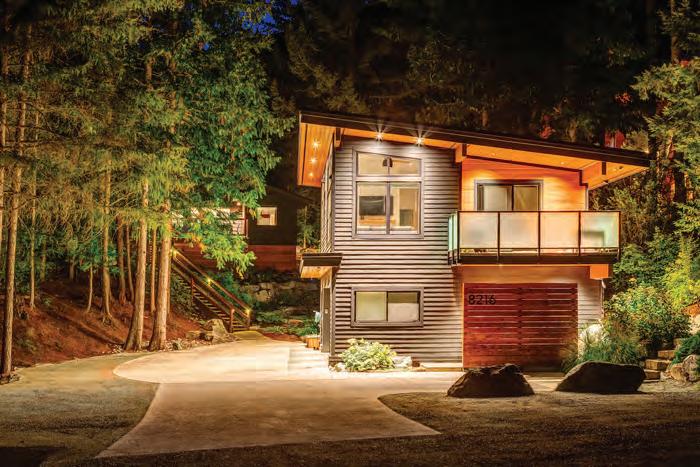



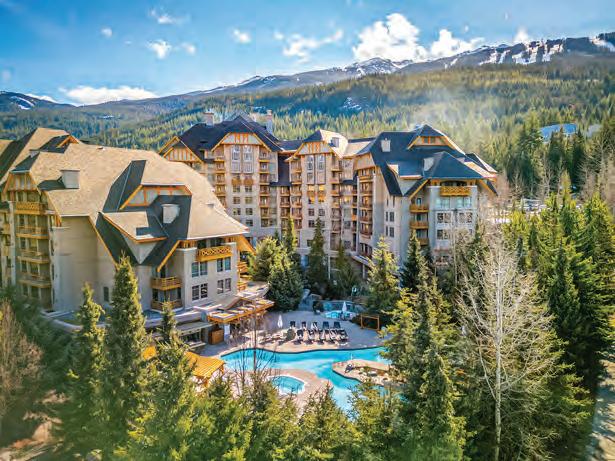




‘More moderation’: Whistler council advances revised Creekside plan
REVISED CONCEPT RESPONDS TO DENSITY, TRAFFIC AND CHARACTER CONCERNS AS STAFF PREPARE FINAL DRAFT FOR DECEMBER ENDORSEMENT
BY LUKE FAULKS
Local Journalism Initiative Reporter
WHISTLER COUNCIL HAS MOVED one step closer to adopting a new vision for the Whistler Creek West (WCW) neighbourhood, after staff presented the results of a summerlong public engagement process and a revised land-use concept reflecting residents’ feedback during an Oct. 21 meeting.
The plan, first introduced in spring 2025, establishes a framework for future redevelopment of WCW, an area identified for incremental infill and revitalization close to the Creekside base. It proposes a mix of mid-rise and low-rise housing, smallscale commercial and enhanced pedestrian infrastructure along Lake Placid Road.
While still conceptual, the plan anticipates a long-term growth scenario of 900 to 1,000 housing units—roughly triple current levels— emphasizing employee and rental housing, modest commercial expansion, and enhanced connectivity across Highway 99.
The development in question is located around Lake Placid Road on the west side of Highway 99. It divides the zone into four subareas with varying density and height limits.
Sub-area A, on the north side of Lake Placid Road, envisions mid-rise residential buildings (four to six storeys) with potential for local-
serving commercial uses at street level;
Sub-area B, located between A and C, serves as a transition zone with three- to four-storey buildings;
Sub-area C proposes small-scale multiunit housing (up to six units per lot) aligned with Whistler’s frequent bus service;
Sub-area D, adjacent to Highway 99, allows three- to five-storey residential forms and retains existing site-specific commercial uses such as Whistler Creek Lodge.
Staff are also pursuing a commercial landuse analysis, transportation and viewscape studies, and a development feasibility review to fine-tune the concept before it returns to council.
Public feedback gathered between June 4 and July 6 via an online questionnaire, open houses, and presentations to advisory committees revealed broad but divided sentiment.
Traffic and transportation topped the list of concerns, with residents calling for improved flow at the Highway 99/Lake Placid Road intersection and better cycling and pedestrian infrastructure. Staff said a transportation study is underway to recommend intersection upgrades and safer crossings.
Affordable and employee housing were also recurring themes. Participants urged Whistler to ensure affordability for both seasonal and long-term workers, with divided views on
whether employee-restricted housing should be integrated throughout the neighbourhood or concentrated in certain areas.
Some respondents endorsed small-scale shops and services to strengthen the Creekside hub; others worried about competition with existing businesses.
Dozens urged planners to retain Creekside’s “modest, mountain-town” feel, preferring natural landscaping and architectural continuity over contemporary styles.
Opinions on density and building height were mixed; some respondents supported higher density to ease the housing shortage, while others feared an “urban-like” feel or the loss of “modest, mountain-town feel.”
At the Oct. 21 meeting, councillors pressed staff on parking, water-table constraints, and green space.
Councillor Cathy Jewett noted public preference for “more moderation” in building heights and questioned whether additional commercial use could worsen traffic. Planning analyst Megan Mucignat said underground parking is expected for larger buildings, though feasibility will depend on site conditions.
“That’s what we would imagine for the larger buildings,” she said, noting ongoing work with transportation engineers.
Staff also confirmed that while a Highway 99 underpass already exists north of Lake
Placid Road, options for safer crossings— including long-term consideration of an overpass—remain on the table.
Further to that, new transportation, urban design, and commercial landuse studies are also underway. These include: A transportation impact assessment addressing vehicle flow and pedestrian safety at Highway 99 and Lake Placid Road; a viewscape and solar analysis to model shadowing and skyline impacts of taller buildings; a land-use feasibility study on proposed housing types, densities and land uses proposed for the WCW Plan; a commercial feasibility study to determine how much local retail the area can support.
Coun. Jeff Murl, who chairs the Housing and Strategy Committee, said he looked forward to the results of the feasibility study in particular.
“I’ve been told, especially at housing strategy, that that is critical to making this a worthwhile endeavour, and so it would be a shame if all this work is not backed by that analysis,” he told council.
Council unanimously received the Phase 2 engagement report and directed staff to bring forward the finalized WCW Neighbourhood Plan for endorsement in December. If approved, accompanying Official Community Plan and zoning bylaw amendments would follow in early 2026. n










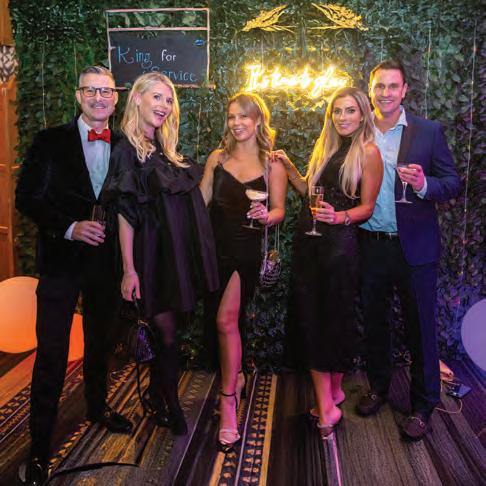



HonouringtheLife of
Norm Barr
February13,1932–October21,2025
The passingof NormBarr, atthe age of93,markstheendofanimportant erainSquamish’s history.

Bo rn inAl ta Lake (W histler)on February13,1932,Normwas raised inSquamishdurin g th e di ff icul t Depressionyear s ofth e “Dirty Thirties.”Likemanyyoungmenof hisgeneration,hewenttoworkinthebushafterhighschool.Through hardwork,intelligence,anddetermination,hebuiltasuccessfullife andcareerintheloggingindustry.
Normearned a reputation asone ofthe mosthonestand trusted logging contractorsonthecoast.A handshakedealwithNormBarrwasas solidastheycome—hehonouredeverycommitmentandpaidevery bill.Hishonestyandintegritywerethecornerstonesofhislongand respectedlife.
Inthe 1950sand ’60s, whencommunityprojects depended onvolunteer effortandlocalgenerosity,Norm,alongwithhisemployees,business colleagues,and their families,gavefreely oftheir timeand equipment. Theircontributionshelpedbuildmanyofthefacilitieswestillenjoy today, including the Squamish General Hospital, SquamishCurling Club,SquamishGolfClub,SquamishAirport,SeniorsHousing, CentennialField,LoggerSportsGrounds,andtheoriginal outdoor pool besidethehighschool.
Alongside Mayor Pat Brennan and Dr. LaVerne Kindree, Norm servedonmunicipal councilduring a periodofmajor growthand transformation. Togethertheyhelpedleadthe amalgamationofthe VillageofSquamish,GaribaldiHighlands,andBrackendaleintoone municipality Their workfocused ondevelopingthe infrastructure thatshapedmodernSquamish—upgrading and interconnecting the water system, building two secondarysewagetreatment plants, establishingthe riverdikingsystem,andcreatingthefirst affordable seniors’housing projects (Cedars and The Manor).Normwas the last survivingcharterboardmemberoftheSquamishSeniorLiving Society The Brennan ParkLeisure Centre remains oneofthe lasting communityachievementsfromhisera.
Knownforhissenseofhumour, Norm onceteamedupwithhisfriend NickCandy torun for councilunder the light-hearted “Candy-Barr” campaignbanner—areflectionofhiswitandgoodnature.
Alltoooften,thecontributionsofimportantcommunityleaderslike NormBarrfadefrommemory, evenaswecontinuetoenjoy the benefits oftheir hardwork. But his legacyiswritten all aroundus—in the facilities,infrastructure,organizations,and the sense ofcommunity hehelpedbuild.
May NormBarr restinpeace,havinglived a lifeofintegrity, generosity,andservice—alifetrulywelllived.
Lovinglyrememberedbyhi s family, friends,an d th e Squamish community.
BC Housing backs Cheakamus Crossing Phase 2 after cash crunch
THE PROVINCIAL CROWN CORPORATION HAS COMMITTED $54.5 MILLION IN FUNDING AND GRANTS FOR 125 NEW WORKFORCE HOMES IN WHISTLER AFTER A FUNDING GAP EMERGED IN SEPTEMBER
BY LUKE FAULKS
Local Journalism Initiative Reporter
CONSTRUCTION OF THE NEXT phase of Whistler’s Cheakamus Crossing neighbourhood is moving forward after BC Housing confirmed it will provide $54.5 million in grant funding and financing to support the workforce housing project.
The funding, announced Oct. 23, helps secure the future of the 125-unit development at 1600 Mount Fee Road (previously referred to as Lot 3), part of what’s known locally as Cheakamus Phase 2. BC Housing’s support comes after some uncertainty about whether the Resort Municipality of Whistler’s (RMOW) development arm could continue building without an external partner.
$54.5 MILLION IN PROVINCIAL FUNDS
According to BC Housing, the Province will provide approximately $6.3 million through a BC Builds grant and $48.2 million in financing toward the project. The RMOW and its subsidiaries are contributing $5.7 million and the land, valued at $3.2 million.
“Housing is essential for the people who keep our communities strong and running,” said Housing Minister Christine Boyle in a release. “Through BC Builds, we are fasttracking new homes that are within reach for middle-income earners, designed to meet the needs of local workers and families who make Whistler thrive.”
The five-storey wood-frame apartment building will include 105 units—mostly studio and one-bedroom apartments, with some two- and three-bedroom options— alongside 20 three-bedroom townhomes intended for families.
Construction began in June 2025 and is expected to finish in late 2027. The Whistler 2020 Development Corporation (WDC) is acting as the general contractor, while the Whistler Housing Authority (WHA) will own and operate the rentals once complete.
WHISTLER’S HOUSING PARTNERS WELCOME SUPPORT
Whistler Mayor Jack Crompton called the provincial support “an important funding contribution” that will help maintain Whistler’s long-standing success in housing local workers.
“We’re proud that 75 per cent of Whistler workers live in town, thanks to decades of building homes for Whistlerites,” Crompton said. “We’re grateful for this important funding contribution from the Province,
which will ensure this success story continues and that the families who make tourism happen continue to have Whistler as their liveable, sustainable mountain home.”
Marla Zucht, general manager of the WHA, also emphasized the value of the partnership.
“The Whistler Housing Authority acknowledges that the success of nonmarket housing projects like this one would not be possible without the support and partnership of the Province, through BC Housing,” she said.
Tourism Minister Anne Kang said the project is a key investment in the province’s resort economy.
“These 125 new homes will give more hospitality workers the ability to work closer to home, stay connected to Whistler’s thriving community, and attract and retain its workforce,” she said.
FUNDING CLOSES MAJOR GAP FOR WDC
The financing marks a turning point for the WDC, which had been operating near its borrowing limits while awaiting external funding to keep construction going.
In September, Whistler council voted to extend a $1-million repayment deadline for the WDC to relieve near-term cash pressure while it sought financing for Lot 3. Municipal staff warned councillors that if funding did not materialize by fall, the project could face a $5- to $6-million shortfall, or, in the worst case, force the RMOW to assume the project’s roughly $60-million cost.
Council also approved a $5.9-million equity contribution to support the project, contingent on securing at least $6 million in external grant funding.
Confirmation from BC Housing in September allowed the project to move ahead.
“The confirmation of funding from BC Housing was sufficient to allow the project to progress and for the sale of the land to the WHA,” the municipality told Pique in an email. “Project delivery and financing will now be able to flow as the project has the financial commitments necessary for all parties to enter into construction financing agreements.”
MEETING GROWING HOUSING DEMAND
The project aims to ease pressure on Whistler’s long rental waitlist, which BC Housing said includes 642 applicant households, 89 per cent of whom are seeking studio or onebedroom units.
BC Builds is part of the Province’s $19-billion housing investment, supporting the construction of more than 3,900 homes across B.C. for middle-income earners. n



SLRD adopts reconciliation guide charting a ‘living’ path forward
GUIDE ENSURES ‘RECONCILIATION IS NOT SYMBOLIC, BUT SYSTEMIC,’ SAYS BOARD CHAIR JEN FORD
BY LUKE FAULKS
Local Journalism Initiative Reporter
THE SQUAMISH-LILLOOET Regional District (SLRD) has formally adopted Truth & Reconciliation: In Practice, A Guide for Working in a Good Way, a document outlining how the organization intends to translate nearly a decade of reconciliation pledges into daily governance.
Since declaring itself a “Regional District of Reconciliation” in 2016, the SLRD Board has endorsed several Calls to Action from the Truth and Reconciliation Commission and committed to aligning its work with the United Nations Declaration on the Rights of Indigenous Peoples (UNDRIP). Board Chair Jen Ford called the new guide “just the next step of that declaration,” offering a pathway for how staff and elected officials “intend to show up in a good way.”
“It’s not a binding contract. It’s not prescriptive,” Ford said. “It’s really intended to make our commitment to being curious and being intentional and being thoughtful whenever we work together. We were calling it a framework, which can be very restrictive, and that’s why it’s now a guide.”
The 2025 Guide was prepared with Gwen Bridge Consulting, drawing on engagement sessions with Lil’wat, St’át’imc and Sk_wx_ wú7mesh (Squamish) Nations, staff and municipal partners.
Ford described it as a way to “put a lens over decisions that we make, to open the minds of all of our staff and all of our board” so each decision prompts the question: “How does this impact the Nations, and who should we be talking to?”
Per the SLRD Guide’s executive summary, the document consolidates years of relationship-building, workshops and surveys into a single “living document that will evolve over time to reflect ongoing learning as relationships deepen.” The work was informed by reviews of UNDRIP, the TRC Calls to Action and policies from peer regional districts.
Internally, the Guide asks each department to develop its own action plan to embed reconciliation in policy and service delivery.
The SLRD has committed to annual Indigenous-led training for all employees and elected officials and to revising policies that conflict with regional First Nations’ governance or rely on “outdated concepts of sovereignty.”
“The Guide is not a finish line, it’s a foundation,” Ford told the Board in October. “It will direct our work in real, tangible ways— ensuring that reconciliation is not symbolic, but systemic, sustained and seen in the everyday lives of the people we serve.
“We are going to stumble along the way, but we will learn and adapt as we go.”
The guide is part of the SLRD’s “inclusive regional governance” through relationshipbased initiatives and advocacy for provincial

2:30 -4:30pm Hear fromthebuilderat3pm Snacks andref reshmentsavailable

reform, aligning with the Declaration on the Rights of Indigenous Peoples Act’s (DRIPA) Action Plan item 1.11, which specifically commits B.C. to supporting First Nations participation in regional-district boards.
Still, tune into any board meeting, and you’ll see Squamish, Whistler and Pemberton’s mayors at the table, along with representatives from the four areas that comprise the rest of the land and unincorporated communities within the SLRD. But you won’t see official representation from the Lil’wat, St’át’imc or Sk_wx_wú7mesh (Squamish) Nations.
The barrier to Indigenous participation on regional districts, Ford explained, is structural. Under B.C.’s Local Government Act, only municipalities, electoral areas, and Treaty First Nations can hold seats on regional-district boards.
There are only eight treaty First Nations in the province—meaning a First Nation that has signed a treaty for self-governance negotiated between the Nation, B.C. and the government of Canada. The modern era of treaties kicked off with the Nisga’a Nation in 2000.
“We don’t have any treaty nations within our Regional District,” explained Ford. “And so, legislatively, we don’t have a seat for them.”
By contrast, “Alberni-Clayoquot Regional District has a treaty nation, and so the treaty nation does hold an elected seat at their board,” she said. She added that within
the SLRD, “any person that lives within B.C. can run for one of the electoral-area director seats,” but Indigenous governments themselves cannot appoint a voting director without legislative change.
Ford said the SLRD has pressed the Province to explore options for Indigenous participation, particularly as part of regional service commissions.
“We won’t go forward with the Regional Transit Commission unless Lil’wat and Squamish can hold official seats at our commission,” she said. “And there are still tricky parts to that, we need an Order-in-Council from the Province so that they can hold those seats.”
While the concept enjoys “nodding heads” in Victoria, Ford cautioned that aligning the provincial legislation that underpins regional districts with UNDRIP and DRIPA will take time.
“It would be decades of work to engage every regional district,” she said. “To make that kind of a change would not be simple. I think we’ll see it sometime in our lifetime, but I don’t know when.”
Ford defined success on the reconciliation file over the coming years as “strong partnerships and inclusive decision-making that really takes seriously our commitment to the neighbours of our region that we work together.
“I don’t think there will be a finish line to this,” she said. “It’s an everyday, ‘have we moved the dial?’ And I think we’ll get there—I’m hopeful.” n
SpelkúmtnCommunityForest NoticeofPublic Viewing
ForestStewardshipPlanReplacement 60-DayPublicReviewandCommentPeriod
TheSpelkúmtnCommunityForest,apartnershipagreementbetweentheLil’watNation andthe VillageofPembertonhasdevelopedareplacementForestStewardshipPlan (FSP)fortheSpelkúmtnCommunityForest.TheFSPpreparedwillreplacetheoriginal FSPuponexpiryinDecember2025.
TheSpelkúmtnCommunityForestissubmittingforapproval,fromtheBCMinistryof Forests,areplacementForestStewardshipPlan(FSP).ThereplacementFSPisproposed foratermof5years,andwhenapproved,willformthebasisofforestmanagement planningwithintheCommunityForest.AnapprovedFSPisrequiredtoallowforthe issuanceofpermitsauthorizingroadconstruction,harvestingandotherforestmanagement activities.TheFSPhasbeenpreparedtoconformandcomplywithapplicableHigher-Level Plans,the ForestandRangePracticesAct andtheassociatedregulatoryframework.
AsperSection20ofthe ForestPlanningandPracticesRegulation,noticeishereby giventoallGuides,Outfitters, Trappers,PrivateLandowners, TenureHolders, Water UsersandthegeneralpublicthatsubmissionoftheFSPforapprovalispending completionofapublicandstakeholderreviewandcommentperiod.Inputisrequested fromstakeholdersandfromthegeneralpublicsothatanyconcernsorcommentscan beaddressed.
TheproposedFSPandmappinginformationisavailableforviewingduringthe60-daypublic reviewandcommentperiodcommencingNovember10,2025,throughJanuary16,2026. TheFSPandassociatedinformationwillbeavailableforreviewduringregularbusiness hoursat:
Lil’watForestry VenturesOffice IR10Road MtCurrie,B.C. Mon-Fri,8:30am-4:30pm Contact:Klay Tindall,RPF604894-6115
PembertonandDistrictLibrary 7320ACottonwoodSt PembertonB.C. Regularoperatinghours Contact:FrontDesk
Inordertobeconsidered,commentsregardingthisplanmustbeinwriting(regular postoremail),andreceivednolaterthan January16,2026.Commentsshouldbe addressedto:
AdrianLitz,RPF ChartwellResourceGroupLtd. 201-1121CommercialPlace SquamishB.C.V8B0S5or alitz@crgl.ca
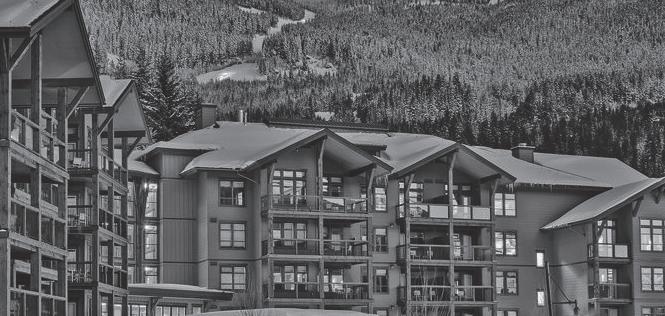
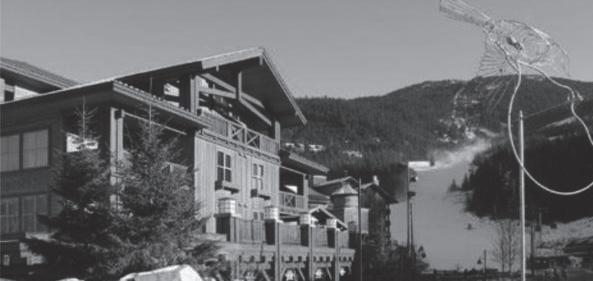





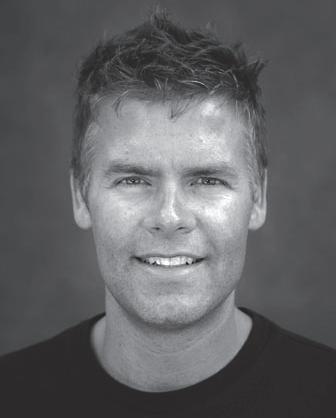
•Access: Insulated14’ rollupdoor, front&reargradedoors
•Ceilings:25’highforflexibleuse
•Parking: 2exteriorstallsperlot
•Expansion:Mezzanineoption
•8 and 3baypurchaseopportunities
•Single Bayleasesavailable er ON










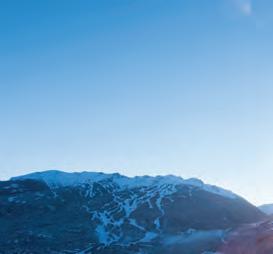



























Florence (Strachan) Petersen
OCT. 31, 1928-AUG. 28, 2012
The Resort Municipality of Whistler from time to time recognizes certain persons in the community who have contributed of themselves to help make Whistler a better place for all to enjoy.
The community recognizes these outstanding contributions by declaring them: “Freeman of the Resort Municipality of Whistler.”
BY BOB BARNETT
PEOPLE WHO KNEW Florence Petersen inevitably learned the story of how she and four school-teacher friends came to Alta Lake in the summer of 1955 and bought Witsend, their weekend/ summer retreat on the west side of the lake. And thus began, one assumed, Florence’s interest in the people of Alta Lake and their stories, the long prelude to her opening the Whistler Museum and Archives in 1986.
But in 1955, at age 26, Flossie’s focus wasn’t on the past but the future—1956 in Australia, to be specific.
Flo was a P.E. teacher at Burnaby North high school, the same school where as a student a decade earlier she had been introduced to field hockey. It became her passion.
After graduating high school she won five Greater Vancouver Women’s Hockey League championships with the Kitsilano team. She also became one of the first A-rated umpires. In 1953, while on a teacher exchange in England, she represented Canada at an international field hockey conference and tournament in that country. That led Florence, on her return home, to spearhead Canadian involvement in international play, including the 1956 IFWHA tournament in Australia.
In addition to playing in the 1956 tournament, Flo was co-chair of a local committee charged with raising funds to send the Canadian team to Australia. Among her initiatives was writing and publishing her first book, a history of grass hockey in Vancouver. Copies sold for 25 cents.
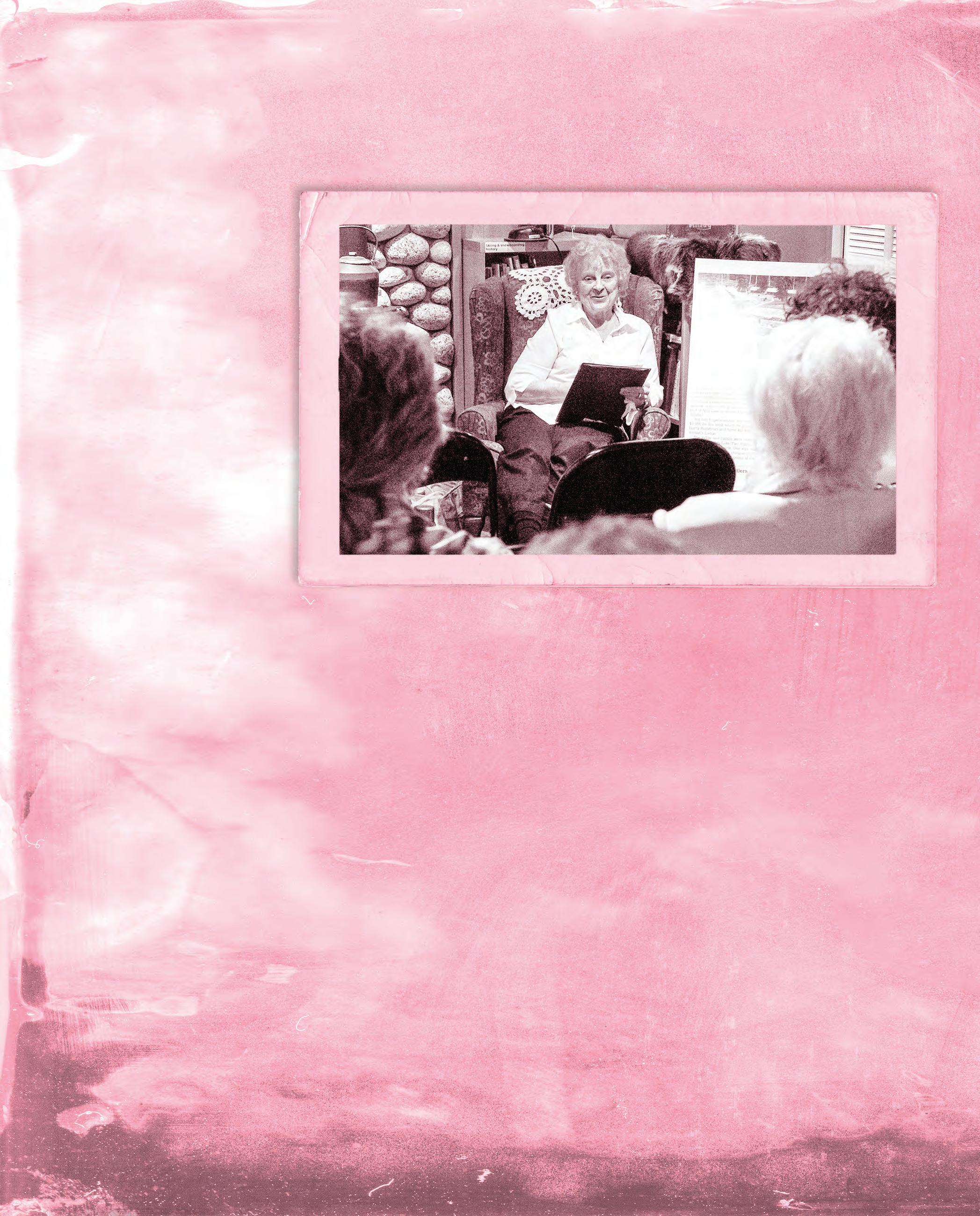
She, of course, went on to write or co-author three books on Whistler’s history: First Tracks, Whistler’s Early History; The History of Alta Lake Road; and Whistler Reflections (co-authored with Sally Mitchell and Janet Love Morrison). All of her books reflected her dedication and commitment to the subject.
With field hockey, “It was Flossie who got us on the road to international play,” says fellow Field Hockey Canada Hall of Fame member Barb Hart Harris.
With Whistler, it was Florence’s promise to Myrtle Philip and Dick Fairhurst to preserve the memories of early Alta Lake and its residents; the time before skiing arrived.
Witsend was central to her Whistler commitment.
In a valley of loggers, trappers and a few lodges, accessible only by train, residents
took note of the arrival of five young women. They so charmed the seller of the cottage, Thomas Masson, that he knocked $500 off the price. When they offered to pay cash he took another $500 off. The total paid for the furnished cottage with a rowboat, wharf and toolshed was $1,500.
The five teachers named their cottage after a metaphorical destination following one particularly exhausting trip. It started at 9 a.m. at the steamship dock in Vancouver and concluded well after 5 p.m. following a half-mile walk, carrying food and provisions—in pouring rain, from Rainbow Station to the cottage.
Witsend was located in the heart of the community, between Rainbow Lodge, which Myrtle and Alex Philip built, and Cypress Lodge, built by Dick Fairhurst (now the site of The Point Artist-Run Centre). The lodges were the focal point
of the community, hosting holiday celebrations and special events.
Although the Philips had sold Rainbow Lodge in 1948, Myrtle lived in a cottage just a few doors down from Witsend.
In 1956, three of the teachers, including Florence, bought Lot 14, next door to Witsend. When the cottage burned down in 1965, after it had been wired and insulated for the first time, Florence rebuilt on Lot 14. That same year she met Andy Petersen. They married in 1967. Andy, a carpenter, stayed in Whistler while Florence taught in Burnaby during the week and returned to Whistler on weekends.
It was during the weekends and summers that Florence got to know Myrtle, who had lived in the valley since 1913. Myrtle left about 3,000 photographs and hundreds of objects that became the physical foundation of the Whistler






PHOTO COURTESY OF THE WHISTLER MUSEUM / WHISTLER MUSEUM COLLECTION
Museum and Archives. The collection was augmented by Florence’s diligence in gathering old timers’ tales and her understanding of life in a valley with no electricity and only a railroad connecting it to the outside world.
When Florence retired from teaching in 1983 she moved to Whistler to be with Andy and began to focus on building the museum. With virtually no funding, she covered registration, training and office expenses herself.
Her efforts culminated in the opening of the Whistler Museum in 1986, in a corner in the back of the library—which itself was confined to a vacant space under municipal hall. Myrtle Philip came in a wheelchair from the Squamish seniors centre for the opening.
“She saw our little sign that read ‘The start of the archives’ and she saw some of the things on display. She knew it would grow into something,” Florence recalled.
Myrtle passed away less than three weeks later.

her warmth and energy made others feel comfortable, a part of the community. One example: she and Andy hosted dinners and made their house a second home for young RCMP officers new to town.
And then there are the 1,000-plus couples she helped start their lives together during her time as district marriage commissioner, between 1984 and 2004. By their nature, weddings are optimistic beginnings, but Florence also made them fun. And she loved to hear what couples were doing with their lives in the years following their marriage.
Weddings were often an adventure. She did them on mountaintops and on mountain bikes; in hot tubs and in snow storms; on bungee bridges and on surprise occasions (she did two weddings where the brides weren’t informed they were getting married until Flo showed up). For several years, Japanese couples were keen to wed in Whistler. And Florence presided over a massive vow-renewal ceremony on Blackcomb during Whistler Reunion 2000.
“We all knew things were going to change dramatically when the ski lifts were built in 1965. After all, our summer paradise had been discovered.”
- FLORENCE PETERSEN
For her perseverance in opening the museum, Florence was named Whistler’s Citizen of the Year in 1986. The Whistler Museum and Archives Society was officially registered in 1987. Flo served on the board until 1999, although she continued to be an encouraging, supportive resource for museum staff to her last days.
Florence wasn’t always comfortable with the transformation skiing brought to the valley. As she told Michel Beaudry in a 2007 interview: “We all knew things were going to change dramatically when the ski lifts were built in 1965. After all, our summer paradise had been discovered. But nobody could have dreamed then just how big the changes would be! I wish sometimes we hadn’t been in such a hurry to ‘civilize’ this place…”
Conflicted as she occasionally felt about Whistler’s growth, it’s because of Florence’s efforts that newcomers have some sense of Alta Lake’s history. She put together a slide show presentation called The B.S. of Whistler, B.S. meaning Before Skiing. Part of the presentation was incorporated into the Chamber of Commerce’s Spirit Program for new employees.
“That was my main theme in putting the museum and archives together,” Florence said. “That was my pledge to Dick and Myrtle and the others, that they would be remembered.”
People were important to Florence, and
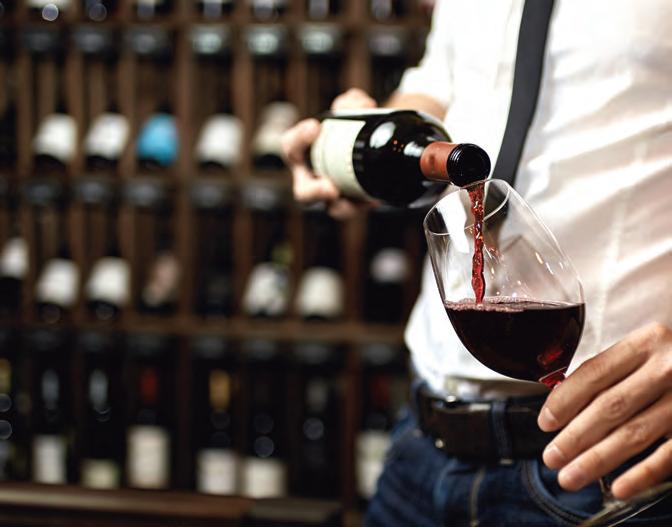


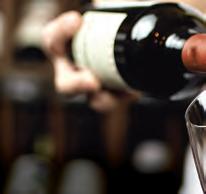

Often Florence would be called upon to do multiple weddings in a single day. On one such occasion her first was at Edgewater and then she rushed to Brew Creek for the second. The timing was a little too compressed, however, and Florence used the bride’s name from the first wedding at the second. The wedding party erupted in laughter: the name used was the groom’s ex-girlfriend’s.
Despite all the helicopter rides and spectacular settings on the mountains, one of Florence’s favourite weddings was on a floating dock on her beloved Alta Lake, with all the guests arriving by boat. It captured the aura of the valley, she said.
For all she did in Whistler, but perhaps just as much for her warmth and enthusiasm, Florence received the Freedom of the Resort Municipality of Whistler in June 2012. Sadly, unexpectedly, she passed away at her home just a couple of months later.
This is Part 10 in a 21-part series recognizing Whistler’s Freedom of the Municipality holders, in honour of the Resort Municipality of Whistler’s 50th anniversary. Watch for the others in the weeks ahead, and find them all at piquenewsmagazine.com.
Bob Barnett is the founding editor and co-publisher of Pique Newsmagazine. n

Developer lays out vision for Alders neighbourhood in Pemberton ahead of Nov. 15 info session
INNOVATION BUILDING GROUP’S
ROD NADEAU SAYS THE PROJECT AIMS TO BALANCE FAMILY HOUSING NEEDS WITH ENVIRONMENTAL STEWARDSHIP
BY LUKE FAULKS
Local Journalism Initiative Reporter
PEMBERTON RESIDENTS will have a chance to hear directly from the developer behind the contentious Alders development later this month, as Whistler’s Innovation Building Group (IBG) prepares to host a public information session aimed at clearing the air on the long-debated project.
The session will take place Saturday, Nov. 15, from 2:30 to 4:30 p.m. at the Pemberton & District Community Centre.
“We’re not trying to hide anything or withhold information,” IBG managing partner Rod Nadeau said in an interview. “We just didn’t have definitive answers until now. We finally got provincial signoff on the environmental report on Oct. 23, and our floodproofing study was finalized [last] week.”
A PROJECT UNDER SCRUTINY
The pro posed subdivision would add four new single-family lots on an extension to Willow Drive, along with three single-family and 17 fourplex lots on an extension of Urdal Drive. It remains “under initial review” on the Village of Pemberton’s development portal.
The project has drawn criticism in recent months, with residents raising questions about flooding, riparian setbacks and the transparency of the approval process. Council has received regular correspondence about the development since May, prompting Mayor Mike Richman to request that the developer
hold a public information session to share more details.
Nadeau noted the land is already zoned for subdivision, and that the time for public input would have been during the original OCP amendment process. Pemberton’s chief administrative officer Elizabeth Tracy shared a similar assessment during the Oct. 21 council meeting.
“This land is already zoned,” Nadeau explained. “The public portion of the process for this is over. It’s now a professional approval process through the approving officer, planning and engineering.”
He emphasized that IBG is proceeding under provincial and municipal regulations, including the province’s flood-hazard and environmental guidelines.
ENVIRONMENTAL REPORTS AND RIPARIAN PROTECTION
Environmental review has been central to the Alders debate.
Nadeau said his company commissioned multiple environmental assessments to ensure the subdivision meets provincial riparian protection standards.
“The original owners hired Cascade Environmental in 2006,” he said. “That’s stale-dated, so we hired Cascade again in 2025, and then hired a second firm, Chartwell, to cross-check their findings. We adopted the more conservative of the two reports.”
Nadeau said roughly 28 per cent of the property—identified as sensitive riparian habitat along the Arn Canal—will be dedicated as parkland to the Village of Pemberton, far exceeding the required five-per-cent dedication for subdivisions.
“We’re taking this very seriously,” he said. “We build high-performance, climateresilient, energy-efficient buildings, and that extends to how we place and construct them.”
ADDRESSING FLOOD RISKS
Nadeau sought to reassure residents that flood-related concerns have been thoroughly addressed.
“The whole village is in a floodplain,” he said. “We’re not doing anything different than the residents of Willow or Alder have done on their properties.”
He said each home will be elevated above the flood-construction level and constructed from insulated concrete forms. There will be a garage on the ground floor. So, if and when waters rise, and residents come downstairs to a muddy garage, clean-up is relatively straightforward.
“If it gets wet, you hose it out, let it dry, and you’re done,” Nadeau said.
Following direction from the approving officer, IBG has also engaged a provincial flood specialist to confirm the project’s elevations and mitigation measures. A detailed stormwater management plan, completed earlier this year, uses infiltration systems to ensure runoff is handled on-site rather than being discharged into Arn Canal.
HOUSING SPECS
Nadeau said the development’s goal is to deliver “attainable, family-appropriate housing” at prices below current market rates.
“There’s nothing in family-sized housing with a three-car garage that’s designed for Sea to Sky families,” he said. “We’re designing homes for people who live here: families with kids, and people with tools, mountain bikes, and gear. That’s real life in Pemberton.”
Homes are expected to start at about $789,000, with upper-floor units priced near $809,000—roughly 25 per cent below comparable townhomes in the area.
Nadeau added the houses will meet Step Code 5 energy standards, incorporating triplepane windows, central air conditioning, ERV
air-filtration systems with MERV-13 filters for wildfire smoke, and the concrete lower levels designed to withstand flood events.
IBG received preliminary layout approval from the Village of Pemberton on Aug. 1, confirming the road alignment and number of lots.
“Now it’s just down to the detailed engineering: the stormwater, sewer, water, hydro, access, lighting,” Nadeau said.
He also noted design features intended to make the new neighbourhood safer and more pedestrian-friendly than nearby streets.
“The subdivision standards don’t require sidewalks, but we’re putting them in,” he said. “We want a place where kids can walk safely.”
Nadeau added that the project’s frontage will be heavily landscaped to reduce the visual dominance of driveways.
“In Willow, 60 to 80 per cent of the street frontage is driveways,” he said. “In ours, it’s eight per cent. The rest is landscaping.”
INVITING DIALOGUE
Nadeau said the upcoming information session will include presentations on the floodproofing, environmental and engineering work, as well as boards showing the subdivision layout and home designs.
“We’ll present the project and all the technical reports,” he said. “And we’re inviting both existing residents and the 200 families on our interest list to attend. That way, the people who live on Alder and Willow can meet the families who’ll be moving in next door.”
He encouraged residents with questions to email him directly at rnadeau@ innovationbuilding.com in advance of the meeting.
“People assume the worst in an information void,” he said. “This meeting is about filling in the [void] and showing that we’re taking environmental protection, flooding and affordability very seriously.” n
Arts Council unveils town’s biggest mural yet on ‘the great grey wall of Pemberton’
VANCOUVER BIENNALE PARTNERSHIP BRINGS BOLD, NATUREINSPIRED ART TO PEMBERTON VALLEY SUPERMARKET WALL
BY LUKE FAULKS
Local Journalism Initiative Reporter
A CROWD GATHERED in the Pemberton Valley Supermarket parking lot on a brisk but bright Sunday afternoon to celebrate the unveiling of a vibrant new mural by local artist Natasha Plumridge.
The Village’s largest mural yet has transformed what supermarket owners once dubbed “the great grey wall of Pemberton” into a sweeping tribute to the valley’s landscape and wildlife.
The massive artwork, commissioned through the Pemberton Arts Council’s (PAC) Outside Voices Mural Project and supported by the Vancouver Biennale, was formally unveiled on Nov. 2 with songs from Lil’wat Nation singers, remarks from community leaders and a ribbon-cutting ceremony attended by the mayor, council, sponsors and local families.
“We can debate and pass bylaws, but these people,” said Pemberton Mayor Mike Richman, gesturing to the mural’s organizers, “are the ones who bring the colour to our town.”
Plumridge said her mural draws inspiration from Pemberton’s “rich culture and natural beauty,” highlighting the deep interconnection between land, water, and people.
“It’s a tribute to the harmony between the land, its people and the Lil’wat Nation’s traditions,” she said, describing the design as “uplifting and joyful, full of bold colours meant to make people happy.”
The piece features eagles, salmon, bears, and native flora like huckleberries, soapberries and fireweed. Those species were identified through consultation with the Lil’wat Nation, whose cultural input helped shape the mural’s design.
Consultation with the Mural Committee also led to a conspicuous absence in the mural: the display of the Valley doesn’t include Mount Currie/Ts’zil—arguably the area’s most iconic, imposing feature. Plumridge said they didn’t want to pull focus from the real thing, in view behind the mural.
Painting began in early September and continued through a challenging fall season of rain and busy supermarket traffic. It wasn’t always smooth going.
“The scissor lift wouldn’t go up unless it was perfectly level, so I used plywood and two-by-fours to make it work. And I was always trying not to block off parking for the supermarket or the sidewalk as much as possible,” Plumridge recalled.
“But my two-year-old daughter also spent the entire two months in the parking lot with me. So, it was challenging but beautiful.”
The Pemberton Arts Council launched its mural initiative with a call for artists in February 2025, receiving more than 30

PHOTO BY LUKE FAULKS
submissions from across Canada. Three were shortlisted, with each artist compensated to refine their designs based on community and cultural feedback.
PAC executive director Cléa Thomas said the project was made possible through funding from the Pemberton Valley Supermarket and done in partnership with the Vancouver Biennale. The collaboration allowed PAC to take on an ambitious public artwork despite limited funding.
“We love these partnerships where we can make wonderful projects happen,” Thomas said in an interview. “We don’t have the budget to do it all, but when someone comes to us and says, ‘Hey, we have a bit of funding,’ we say, ‘yes—let’s do it.’”
Vancouver Biennale, founded in 2004 by Vancouver-based curator Barrie Mowatt, is a non-profit charitable organization that transforms public spaces into open-air art museums. Its mission, Mowatt explained at the event, is to bring “art into the everyday,” inspiring dialogue and learning through accessible public installations.
“It’s wonderful to see the arts appear in such frontal form here,” said Mowatt, who has maintained property in the valley for more than two decades. “We’re thrilled to be able to share some of our experiences in public art here in Pemberton.”
Thomas said the unveiling capped off a “busy and exciting year” for the PAC, following major collaborations like the Grizzly Bear Art Show and the Mountain Muse Festival.
“Pemberton is a great place for the arts, for everyone to try,” she said. “We’re growing now—we’ve just hired new staff and are launching weekly workshops in Pemberton later this year.”
As the ribbon dropped and music filled the parking lot, Plumridge stood alongside her daughter and dozens of supporters. The mural, she said, was as much a personal journey as a public one.
“I love the challenge of learning as I go, and I love that I got to stay home in Pemberton to do it,” she said. “It’s been so amazing— everybody’s been kind and supportive. This mural really belongs to everyone who stopped by and shared their stories.” n













FITTING TRIBUTE Artist Natasha Plumridge worked with her two-year-old daughter on the project.

Which batteries belong in the outdoors?
THERE’S A BATTERY in just about everything these days. E-bikes are ubiquitous in Whistler, which may be great for Whistler’s Big Moves climate goals by reducing traffic and parking congestion, but maybe not so great for the fist-shaking folks on the Valley

BY VINCE SHULEY
Trail telling all those e-bikers to slow down. In this consumerist economy, you can buy everything from self-inflating camping tents, to smart water bottles telling when to hydrate, to gimmicky electric trekking poles with a cattle-prod end to scare off angry wildlife (good luck with those in a hostile bear or cougar encounter).
Most of it sounds (and is) pretty useless, with poor durability and reliability to match. It’s unfortunate that so many electronic products are made so cheaply that their lifecycle is primarily spent in a landfill. But some battery-powered products really do help solve pain points in your outdoor endeavours, or at least help you have a better experience. With Black Friday sales and gift-purchasing season right around the corner, here are a few batteries that are worth consideration for your recreation.
PORTABLE POWER BANKS AND SATELLITE COMMUNICATORS
These ones are no-brainers. With everyone leaning on their smartphone for photos and video in the backcountry these days, it’s easy to get carried away and drain the battery, especially on multi-day trips. Power banks are not too heavy, not particularly expensive and can help you make sure you’re getting back to your vehicle with adequate charge. I’ve written plenty about the critical communication safety net of devices like inReach and Zoleo before and until we get true satellite communication
motor and battery. Make sure to get something with a warranty and try to use it and charge it a bunch of times during the warranty period. If it’s defective, it will fail sooner than later, but spend a few extra bucks and you’ll have fewer inconveniences from failures. A model I’ve had good experience with for camping and general inflation tasks is the Flextail Max Pump, which comes with a one-year warranty.
If you’re a mountain biker looking to downsize your portable handpump and pressure gauge, you can get both of these in one electronic device. The Trek Air Rush Electric
In this consumerist economy, you can buy everything from self-inflating camping tents, to smart water bottles telling when to hydrate…
on our mobile networks (still a ways off from full access and reliability) these devices are your off-grid backcountry lifeline. Forgot to charge your inReach again? Good thing you packed that power bank.
PORTABLE MINI-PUMPS
I first purchased one of these in order to rapidly inflate stand-up paddleboards and pack rafts, but I found myself taking them camping for inflating my insulation-filled sleeping pads (blowing these pads up by mouth will introduce moisture, and damage the down-fill inside the pad). The right pump is light, fits in the palm of your hand and is quick to charge. One piece of advice here is don’t try to go too tiny. The smaller and lighter the pump is, the more fragile its
Pump isn’t cheap, but it comes with an accurate digital pressure gauge and it’s sold by a bike company that makes quality products.
ELECTRONIC BIKE COMPONENTS
This area starts to get a bit controversial for the mountain-bike purists. If you’re dead set against any battery on your bike, then you’ll certainly live without these devices, but hear me out. Wireless shifting has slowly made its way into mountain biking (via road cycling) and there are distinct advantages. No more cable stretch and cable wear, which is a common culprit for rough shifting. These wireless things shift quite fast and more consistently. And if aesthetics matter, you have one less cable on
your handlebar and inside your frame. Wireless dropper posts don’t inherently solve a riding issue, but they do save a lot of hassle with installation. Even if you have your cable housing already routed, upgrading the length of your cable dropper post often means you have to trim the housing. Being able to move a dropper between your bikes can also be especially handy.
Finally, electronic suspension. These shocks are equipped with a motor (in the case of RockShox Flight Attendant) or a solenoid (in the case of FOX Live Valve Neo) and wirelessly connect to sensors at the front and back of the bike. The idea is that these units can sense when you’re in the air after launching a jump, riding over bumps or settling into a long climb and they address your shock compression accordingly. Think of it as a climb switch that can turn on and off very quickly (many times a second), giving you the advantage of firmer suspension in situations that make you faster, like flow trails. There’s a lot more technical mumbo jumbo to dive into here which I will save for another time, but the point is, it works. It really can make you faster on the trail going up climbs, going down descents and going across every type of trail.
Everything in this electronic bike components list is offensively expensive, so I don’t recommend them as a veritable upgrade at this point. It also adds more battery management to your routine, which some folks don’t like. But the innovation will trickle down eventually to more affordable bikes, and it will make our riding lives easier.
Vince Shuley seems to procure more batteries every season. For questions, comments or suggestions for The Outsider, email vince. shuley@gmail.com or Instagram @whis_vince. n
A budget vision looking for delivery
MARK CARNEY was elected as a leader with a mix of elbows and answers. In this age of instant gratification and incessant distraction, he gets one clean shot to define his vision for Canada before he finds himself in the penalty box.
Tuesday’s federal budget, in a normal era, would have been better to say more about who we are than who we don’t want to be. But this is not a normal era. The prime minister’s prerogatives are framed less by national selfdefinition and more by the need to insulate us from American unpredictability. The budget also carries the quieter assignment of undoing or smoothing over some of his predecessor’s most glaring missteps.

BY KIRK LAPOINTE
Thus the step-up in defence, the rush to build housing and the catch-up on infrastructure. And thus the wave of spending on what we hope will drive innovation and reverse our productivity slide. It suggests this is more generational (as in, larger than anything in years) than generative (as in, likely to lock in lasting prosperity). “Investment” is doing a lot of euphemistic work here as a political perfume for tax dollars marshalled to plan a substantial share of the economy.
For now, the exercise looks like a way to endure Donald Trump’s return and fine-tune later. There are gaps because we do not yet know how aggressively the U.S. will squeeze Canada in trade talks. And there is political optionality, because if this budget collapses in a minority-government confidence vote, Carney will want fresh material for a campaign.
Still, this is a portrait of the leader he wants mostly to be in harnessing, building, unifying and diversifying. It wants us to use what we have, move faster and play nicer with ourselves and less often with our neighbour to the south.
The problem with needing to do a lot is the temptation to do it all at once. What we got Tuesday was a manifesto stitched to a spreadsheet. It’s a pastiche of national security assertiveness, climate ambition, housing urgency, industrial policy and technological futurism. It risks being everything and nothing, sprawling in scope and late to crises visible for years.
Carney deserves credit for naming the structural ills of weak productivity, underinvestment, internal trade barriers, painfully slow permitting and capital that too often watches from the sidelines. Canadians have waited for a government that thinks beyond the polling cycle. On paper, this is such a government.
Yet intention is not impact and ambition is not capability. So this time, it’s not a cliché to say time really will tell.
The budget leans heavily on the idea that declaring spending to be investment makes it inherently productive. It pledges balanced operating accounts by 2028-29 and a declining
debt-to-GDP ratio. The test is whether Ottawa can restrain itself from treating every file as a federal file. History is not encouraging.
Housing illustrates the dilemma. A national factory-built construction strategy, bulk procurement, and speedier federal approvals might help. But Ottawa promised to fix housing long before prices tripled. Federal ambition only matters if provinces, municipalities, labour supply, material chains and zoning rules align. They rarely do.
Internal trade reform and labour mobility sound transformative, and the “One Canadian Economy” concept is overdue. But Canada has been pledging to remove internal barriers since the Mulroney era. The budget gestures at enforcement but stops short of telling provinces to drop gatekeeping powers or lose funding. If progress requires unanimous cooperation, little progress happens.
Innovation policy is equally conflicted. Sovereign AI and improved R&D credits are welcome; intellectual property and compute capacity are the currency. But the document also reinforces layers of program gatekeeping. Canada’s startup economy needs faster decisions, consistent regulation and procurement that buys Canadian innovation rather than just applauding it.
The clean-economy agenda is large-scale and aligned with global direction. But the budget walks a shaky line between climate ambition and energy realism. Canada sits on a world-class resource base facing U.S. protectionism and geopolitical flux. Billions in tax credits matter less if mines, pipelines, renewable-energy corridors and export terminals cannot clear courts and consultations. Announcing incentives is easy. Building is hard.
Defence, for once, is treated seriously, not rhetorically. Canada commits to meet NATO benchmarks and expand spending further. It is overdue and necessary, but also signals belated adaptation to a dangerous world and U.S. pressure, not a sudden sovereign awakening.
The result is a document that is not so much ill-considered as it is vulnerable, at once too big and too small, too sprawling to prioritize, too cautious to transform. It tries to re-engineer the economy while managing the political calendar, soothing markets, preempting Trump, placating provinces and restoring public trust after years of shortfalls in delivery. The risk is that we end up with a government that plans more than it builds, directs more than it frees and confuses motion with momentum. Productivity does not rise because a budget asserts it. Productivity rises when regulation is predictable, risk is rewarded and capital moves confidently.
Canadians wanted a reset. If Carney can turn ambition into execution, put shovels in the ground with those elbows up, he may earn the mantle of generational reformer. If not, this will read as the crowded, cautious first and only draft, and his missed moment.
Kirk LaPointe is a Lodestar Media columnist with an extensive background in journalism. He is vice-president in the office of the chair at Fulmer & Company. n



Lest we forget
By
David Song
THIS NOV. 11, Sea to Sky locals and visitors will once again assemble in Olympic Plaza for the annual Remembrance Day ceremony in Whistler, and some of them may well be doing so with a renewed appreciation for military veterans.
Back in February, Whistler hosted five days of the Invictus Games 2025 (IG25): skeleton, snowboarding, skiing and numerous artists who performed in honour of the 500-plus service members who represented their nations. It was a week full of emotion and inspiration: for example, IG25 director of Whistler operations Chelsey Walker shed tears of joy when Assunta Aquino, a retired Canadian Army engineer, won alpine skiing gold in her category.
For many, Invictus presented a tangible example of the sacrifices made by veterans and the grit required to serve one’s country. RCMP Reserve Cst. Steve LeClair, who is organizing the local ceremony for the eighth year, believes the Games may remind people to honour soldiers past and present.
“It was a wonderful event,” he said. “I was on the mountain in Whistler … and it was just really gratifying and heartwarming to see people there really enjoying themselves. Some of them have had very little snow experience. Nice to see as we move from [IG25] into Remembrance Day months later.”
Unlike last year, the upcoming proceedings will feature no cannonade. LeClair received feedback from members of the public who did not believe that a display of simulated gunfire was necessary at previous iterations of the event. Some were bothered
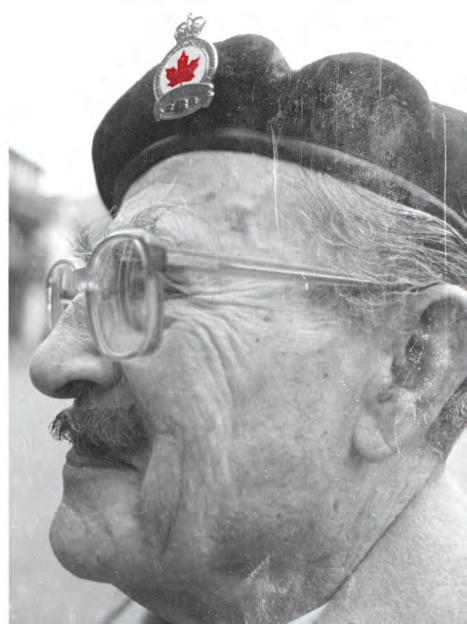
by it, so organizers chose to remove it out of a desire for harmony.
Other aspects of the ceremony are planned to run as usual. A Veterans’ Parade and Colour Party will begin at 10:45 a.m., heading from the Ted Nebbeling Bridge to Whistler’s Cenotaph in the Plaza where sentries are to be posted. “O Canada” and poems of remembrance will precede “The Last Post” and two minutes of silence at 11 a.m. sharp.
Two minutes later, bugles will sound “The Rouse” as Blackcomb Helicopters aircraft fly past in missing man formation, leaving one space among them to represent service members who have died in the line of duty. The service continues with other songs and poems like “In Flanders’ Fields,” a wreath presentation and a prayer with Mayor Jack Crompton in attendance.
The Whistler Singers and Whistler Children’s Chorus will be a key part of things, singing a prelude and an array of songs during the service itself.
LeClair was first asked to helm Whistler’s Remembrance Day ceremony in 2018. The event means a lot to him because the aunts and uncles on his father’s side participated in the Second World War.
“We’ve lost so many Canadians to war: over 66,000 in World War I and over 45,000 in World War II,” said LeClair. “Now it’s been 80 years since World War II ended, and I think it’s really important to remember those people that sacrificed so much … in all conflicts, wars and peacekeeping missions that Canada has been involved in.
“I’m very proud to be part of the [Remembrance Day] organizing committee. The first couple of years I did this, it was a learning curve for me, and now we’ve got it down to clockwork. I’m very happy to be a part of this and I plan to remain a part of it for the foreseeable future.”
Members of Vancouver’s 39 Signal Regiment, who have essentially adopted Whistler as their Remembrance Day venue, will be present once more. They are to be joined by personnel from the HMCS Discovery Naval Reserve and hopefully one or more war veterans.
Although Remembrance Day is primarily observed in tribute to soldiers, LeClair feels it is also a meaningful occasion for first responders who put their lives at stake closer to home in different contexts.
“We get together after the ceremony. There is a lot of camaraderie and mingling between police, firefighters and the various branches of the military,” he remarked. “It’s a willingness to serve, either domestically or internationally, and finding camaraderie in that service with others.”
LeClair went on to discuss other aspects of the event: “The poems are basically symbols of our freedom and not to be taken lightly. The ceremony as a whole is a way for the community to come together and remember those who served and honour their service. I think [local partners like Mayor Crompton, Blackcomb Helicopters and the Whistler Singers] really make the ceremony what it is.”
Visit whistler.ca/parks-recreation-culture/festivals-andevents/remembrance-day for more details about the 2025 Whistler Remembrance Day proceedings (note the absence of a cannonade as mentioned above), as well as to view a livestream that begins at 10:40 a.m. on Nov. 11. n
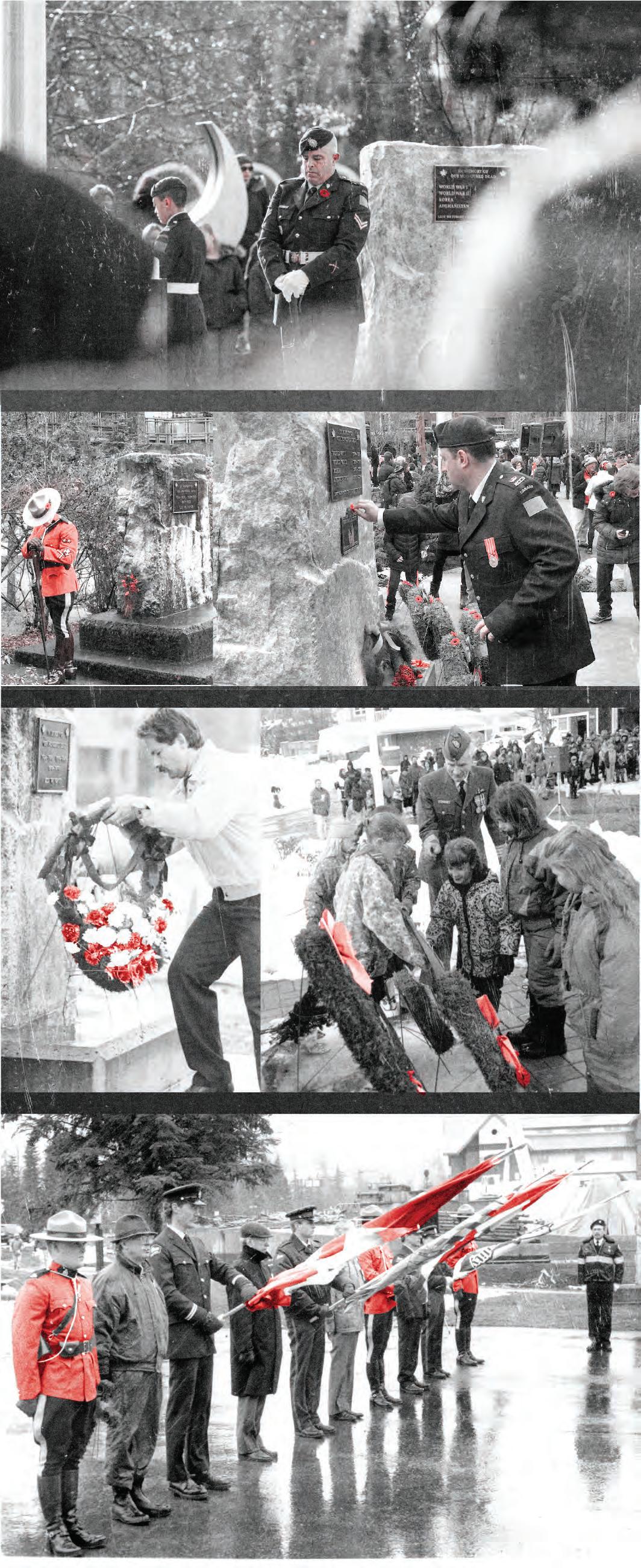


Whistler Service of Remembrance
On November 11, Veterans, Canadian military units, first responders, residents and visitors will gather at the Whistler Cenotaph as we pause, reflect and remember the more than 116,000 Canadians who made the ultimate sacrifice in their service to Canada.
The Service begins with the Veterans’ Parade and Colour Party from the Ted Nebbeling Bridge down Village Stroll to the Cenotaph
The Whistler Singers and Whistler Children’s Chorus will perform songs of Remembrance as well as lead the gathering in O Canada and God Save the King.
The Last Post, Rouse, helicopter fly past, cannon firing, poetry readings, presentation of wreaths and The Act of Remembrance comprise this year’s program.
Our veterans want Canadians to understand the price of freedom. They are passing the torch to people of Canada, so the memory of their sacrifices will continue, and the values they fought for will live on in all of us.
10:30 AM - Monday, November 11, 2024 Whistler Cenotaph Whistler Olympic Plaza
Order of Program:
the Squamish Legion or make one of their design.
Please contact Committee Chair Steve LeClair to volunteer or if you wish to place a wreath on the day. steve.leclair@shaw.ca
Please note that the event will be live streamed at Whistler.ca so that those who wish, may attend the ceremony virtually.









PHOTO BY CLARE OGILVIE
PHOTO BY BRADEN DUPUIS
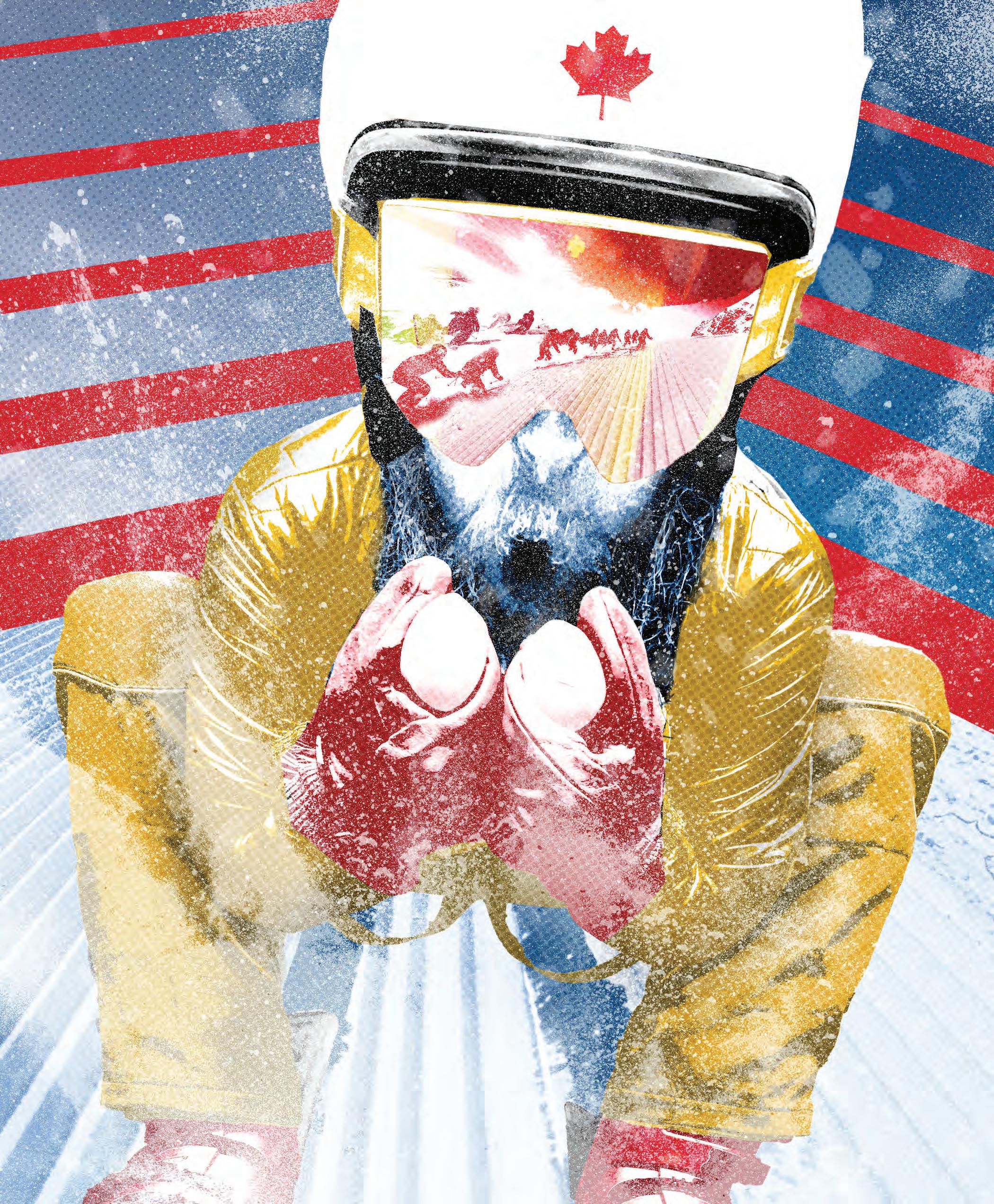


Canadian bobsledders face dearth of funding, organizational change en route to Milano Cortina 2026
THE PROGRAM IS DRIVEN BY VETERAN PILOTS LIKE MELISSA LOTHOLZ AND TAYLOR AUSTIN, PLUS DECORATED COACHES SUCH AS JUSTIN KRIPPS
BY DAVID SONG
WITH LESS THAN 100 DAYS to go until the next Winter Olympic Games in Milan and Cortina d’Ampezzo, Italy, Canada’s bobsleigh team is raring to challenge goliaths of their sport like Germany and the United States—but they’ve faced off-ice giants as well.
Perhaps their most mammoth obstacle to date is funding. Bobsleigh Canada Skeleton (BCS) fees cost $2,000 during the most recent Olympic year in 2022, but have since ballooned to $25,000 (and would have been $30,000 if not for a modest level of donations and corporate sponsorship). This inauspicious trend afflicts Canadians across both summer and winter sports, with little relief in sight.
Melissa Lotholz understands that many things have changed since she began her career 12 years ago, but is trying to roll with the punches in her quest for a third Games and hopefully a medal at last.
“It’s hard sometimes and it’s humbling, but it’s also really beautiful because there’s so many people that are part of your journey,” said the pilot from Barrhead, Alta. “I just have so much gratitude for all the people that have chosen to invest in not only me, but my
team. I think it actually adds a different kind of beauty and weight to what it means to represent Team Canada.
“So many people have literally put their own dollars, blood, sweat and tears into [this process]. It was indirect before. Now we have faces to what those dollars are.”
Canada’s bobsledders have also grappled with controversy in the highest levels of their organization: ex-BCS president Sarah Storey and former high-performance director Chris Le Bihan have both been accused of fostering inadequate safety, toxic culture and overall mismanagement of their governing body.
Storey declined to run for a third term in November 2022, and David Leuty is the current president. Le Bihan was replaced by three-time Olympian Jesse Lumsden.
It is disheartening for Justin Kripps, a two-man champion from Pyeongchang 2018 and four-man bronze medallist from Beijing 2022, to watch numerous younger bobsledders live through a more negative experience than his own. Kripps may not be able to solve the funding quagmire, but he’s committed to making a difference as technical coach.
“I’m trying to help the next generation get opportunities,” Kripps said. “We’ve been putting in time over the last four years with this group … and seeing the amount of progression they’ve had, they’re doing really well. A lot of these men, I wish we had them earlier. We could use more practice … but they’ve been working really hard and gelling as teams. We have a really strong women’s program, their driving is really taking that next step.”
‘WHY NOT US?’
Canada arguably has a reputation to uphold. Past standouts like Kripps, Lyndon Rush and Kaillie Humphries put the Maple Leaf on the map with podiums in multiple disciplines, and the burden of building upon their success rests now upon a diverse group of contenders.
“We have such a rich history of success,” remarked Taylor Austin of Calgary, the nation’s most experienced male driver.
Lotholz, Austin and Cynthia Appiah have been there and done that on an Olympic stage. Fellow pilots Bianca Ribi, Pat Norton, Cyrus Gray and Erica Voss are jockeying for their first taste of the Games.
Propelling them down track is a battery of brakemen and brakewomen with eclectic origins: from Hamilton TigerCats wide receiver Keaton Bruggeling and ex-NCAA Division I diver Yohan EskrickParkinson to former Gaelic football player Niamh Haughey and Kelsey Mitchell, the Tokyo 2020 track cycling gold medallist. Jay Dearborn and Kristen Bujnowski are examples of former brakepeople who have graduated to the front seat.
Winners from the Canadian bobsleigh selection races on Oct. 25 and 26 at the Whistler Sliding Centre (WSC) are as follows: Lotholz (monobob), Austin and Shaquille Murray-Lawrence (two-man), Ribi and Dawn Richardson Wilson (two-woman) as well as the four-man squad of Austin, MurrayLawrence, Eskrick-Parkinson and Mark Zanette. However, Canada’s Olympic lineup
won’t be set in stone until around Jan. 20, 2026 when the international qualification period ends.
“We’re just trying to stick to the process,” Austin said about being a leader for his youthful compatriots. “The biggest thing for us is staying consistent. I’m really trying to enjoy the moment because we’ll be [in Italy] and next thing you know, we’ll be at home.”
Despite being built in the 1920s, Cortina d’Ampezzo’s Eugenio Monti Sliding Centre is basically a new venue after its redevelopment for the upcoming Olympics. Lotholz expects it to be a low-pressure track that puts fewer G-forces onto athletes when compared to the WSC.
Realizing success against deep fields of global opponents is never easy, but Lotholz and Austin have both learned from past experiences to focus on what they can control.
“The Beijing Olympics are a great example, where we were constantly fighting quarantines and different rules. It’s easy to give a lot of emotional energy to those things,” Lotholz reflected. “The big takeaway is to find strength in your routines. Easier said than done when things might look like a dumpster fire around you—which inevitably, sometimes they are on tour. There’s people’s dreams on the line.”
Austin added: “That’s what motivates us to get out of bed every day and put in the work. Especially on a new track, any one of us competing could win, so why not us?” n
TRAINING DAY Melissa Lotholz (left) and Skylar Sieben training in Whistler on Oct. 19. PHOTO BY TODD KOROL
Sascha Gilbert reflects on graduating to Canadian senior national ski team during Olympic year
OTHER WHISTLERITES ON THE ROSTER INCLUDE JACK CRAWFORD, CAMERON ALEXANDER, BRODIE SEGER, KYLE ALEXANDER, RILEY SEGER AND BRODERICK THOMPSON
BY DAVID SONG
FROM THE DAY he committed to competitive skiing, Sascha Gilbert’s goal was obvious: to be selected for Team Canada.
Mission accomplished.
The local athlete spent 2024-25 with the new “CAST D” developmental program, but has now been announced as part of the full Canadian senior men’s alpine ski roster. He’s in the same fold as a number of more experienced Whistler Mountain Ski Club (WMSC) alumni: Jack Crawford, Cameron Alexander, Brodie Seger, Kyle Alexander, Riley Seger and Broderick Thompson.
That’s plenty of experience for him to learn from.
Crawford is the only man to win an Olympic alpine combined medal, securing bronze at the 2022 Beijing Winter Games in addition to World Championships super-G gold one year later in Courchevel, France. Cameron owns four World Cup podiums to date, most recently bronze in Bormio, Italy. Brodie is frequently sighted in the top 15 of any given race and was ninth in alpine combined at Beijing.
“I’ve been playing a bunch of golf with Jack this summer, Cam and Kyle, and getting in the gym with those guys, Brodie and Riley. We all gathered in the spring to do a dry-land camp,” said Gilbert. “I haven’t really been part of a team that big since I was on the Whistler Mountain Ski Club, which obviously looks a lot different to being on the national team, but it’s cool to have a bigger group with lots of personalities.
“They’re really, really inviting. I never feel worried to ask a question or bounce something off of them. Those guys are awesome.”
No doubt the unit’s inspirational core is Thompson, who on Nov. 29, 2023 suffered a life-threatening crash. Despite an uncertain prognosis, the two-time Olympian made his way through rehab and returned to the slopes of Whistler Blackcomb in late November 2024.
“It’s obviously really hard to see something like that happen to somebody you know, somebody who’s on your team … after a traumatic brain injury, it’s always a success story if you’re back living life normally,” Gilbert remarked. “[Broderick’s] able to golf, he’s able to ski, he’s able to do essentially everything he wants to do, and who knows what the future of his ski career is going to look like? Definitely super inspiring.”
‘WE’RE NOT UNDERDOGS ANYMORE’
There are also a handful of Whistlerites on the team’s staff: alpine men’s speed assistant coach Conrad Pridy, ski cross return-to-snow coach Jordan Williams, lead paramedic Cameron


Gant, physician Dr. Karin Kausky, para-alpine lead integrated support Kayla Dodson as well as strength and conditioning expert Laura Strenger.
Gilbert already knows Pridy, who mentored him during his inaugural year of FIS competition.
None of the lineup’s female alpine athletes hail from the Sea to Sky, but Gilbert is still familiar with that group. In fact their World Cup campaign is already underway: Valérie Grenier paced all Canadians with 11th at the Oct. 25 giant slalom event in Sölden, Austria. In Gilbert’s opinion, Grenier is one to keep an eye on alongside Britt Richardson, Justine Lamontagne and Cassidy Gray.
An actual Olympic berth may be unrealistic for Gilbert at this stage of his career—he humbly recognizes that there are faster, more experienced men likely to represent the Maple Leaf at Milano Cortina 2026—but he’s nonetheless grateful to be on the team at such a pivotal time.
“There’s a lot of hype around winter sports,” the 21-year-old said. “I was down in L.A. watching a game of the World Series and talking to people. When [I mentioned I was a skier], the first question is, ‘are you going to the Olympics?’ That’s definitely cool to hear. I think we’ve definitely established ourselves again as a [men’s speed] team to be reckoned with … we’re not underdogs anymore.”
In talking to Crawford, Gilbert realized that a key advantage European ski racers have over their North American counterparts is home snow for much of the World Cup season—and the corresponding luxury to rest at home between races. Yet Gilbert’s best Europa Cup result from last season was 17th in Sarajevo, Bosnia, so he knows he can be competitive.
Much of his focus will remain on the Nor-Am and Europa circuits in 2025-26, with a dash of World Cup action. Gilbert specializes in super-G and giant slalom and believes he’s poised to “put out some highly competitive skiing.” n
PHYSIOTHERAPY NEW!!
2LocationsinWhistler! WhistlerAthletesCentreinCheakamus WhistlerMarketplace119-4368MainSt
SpecialistSportsPhysiotherapists andalso... Concussionrehabilitation• Sportsandspinalphysiotherapy Direct insurancebilling •Gymbasedtraininglaunchingsoon!

Call604962 0555 to make anappointmenttoday. 'wekeepyouplaying'


HAPPY HOUR



STARTINGOCTOBER1ST *NORMALLY$48PLUS TAX AJUG &ANYPIZZAORNACHO FOR$35*WITH TAXINCLUDED! MONDAY TO FRIDAY 3PMTO7PM



Passionateabout adrenaline-fuelledsports? Lovebeingclosetothe action?
VolunteerattheWhistler SlidingCentre!
VolunteersRquiredforEvents: BobsleighandSkeletonRacing -North AmericaCupSeries MondayNov,17-MondayNov24
EmailforAvailableshifts Volunteer@slidebc.ca SIGNUPHERE!



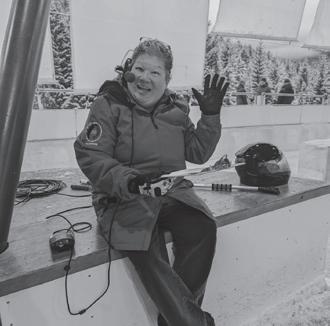








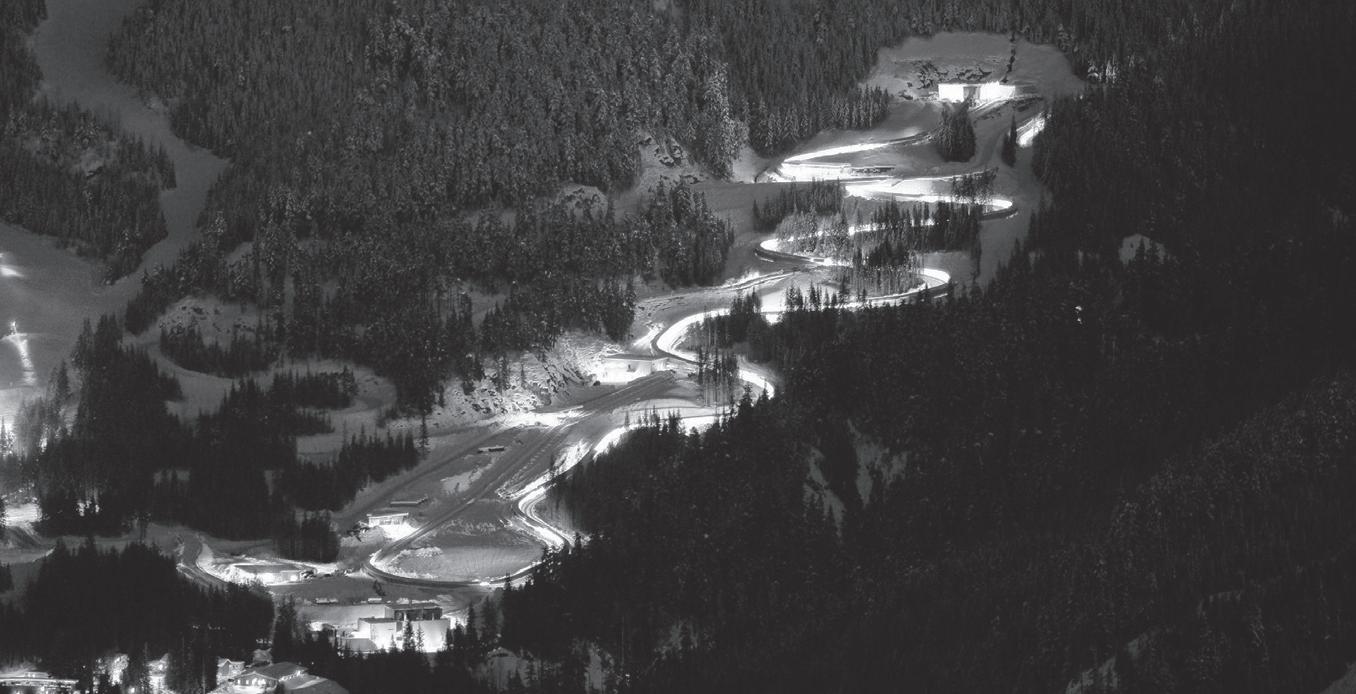



GATE CRASHING Sascha Gilbert navigates a gate during a race.
PHOTO COURTESY OF SASCHA GILBERT

Whistler Blackcomb’s $10 dinners bring the town to the table during shoulder season
A COSY THURSDAY GATHERING AT MERLIN’S BRINGS WHISTLER LOCALS, WORKERS AND FAMILIES TOGETHER OVER COMFORT FOOD AND CONVERSATION
BY LUKE FAULKS
Local Journalism Initiative Reporter
OUTSIDE, RAIN BLEW SIDEWAYS across a quiet Village Stroll. But inside Merlin’s Bar and Grill, the smell of gravy and mashed potatoes hung in the air. Jackets steamed on chair backs, and chatter echoed over the clatter of serving trays. For just $10, Whistler Blackcomb (WB) had turned an otherwise dreary shoulder-season evening into a warm, communal feast.
A TABLE FOR EVERYONE
“It’s really rewarding when you walk into a room and there’s a bunch of like-minded people,” said Wolfgang Sterr, Whistler Blackcomb’s senior director of mountain dining, who helped launch the $10 Community Meal program in partnership with My Epic Promise and Whistler Community Services Society (WCSS).
What began as a spring experiment five Thursdays of low-cost dinners at Merlin’s running in May of this year—returned this fall by popular demand. The concept was simple but resonant: an affordable, sitdown meal open to anyone, served by staff volunteers and supported by food bank ticket donations to ensure no one was left out.
“We wanted to make sure it’s for the whole community,” Sterr said. “We’re truly inclusive, not just servicing on-mountain staff.”
On the second weekly installation on Oct. 23, people showed up, plates were piled with shepherd’s pie, mashed peas, boiled carrots, broccoli, buns and a pool of rich gravy. For dessert: brownies and cupcakes. Members of the RCMP ladled out portions beside managers in aprons.
COMFORT IN THE OFF-SEASON
The meals were designed to bridge the quiet months when hours thin and paycheques stretch.
“When the ski season ends, staff want to stick around but the income dries up,” Sterr said. “We saw a definite need to support the larger population.”
Head chef and organizer Larry Johnson, who has spent more than a decade running kitchens at the Roundhouse Lodge, said the program runs “at cost.” WB makes no profits, produces minimal waste and donates leftovers to the food bank.
“We’re hoping not to lose money,” he said. “If we do have leftovers, we freeze them or donate them. The plan is to have zero waste.”
Johnson said the goal was to create a space that felt welcoming without the pressure to spend big or party. It’s meant to both fill that shoulder-season gap and offer an alternative that people might not associate with Whistler’s vibe.
“There’s already a lot of pressure to go out and drink,” he said. “This gives people an opportunity to still go out, but not have to
drink. It’s a super community vibe.”
FILLING PLATES, FILLING GAPS
The five-week series premiered on Oct. 16 with a Thanksgiving-themed dinner, followed by shepherd’s pie, burrito bowls, chicken parmesan and lasagna. The goal was comfort food, sure, but also to provide a healthy meal to keep people going.
“We want to make sure we provide a nutritious meal. It’s not chicken tenders and French fries,” Sterr explained. “We really make an effort to make it wholesome.”
During the fall season, WB doled out about 300 meals a night to community members. Guests were pleasantly surprised and grateful for the initiative.
For Karina, a longtime Whistler local, the evening was surprisingly lively.
“There’s not many people in town at this time, and then people show up here like this… I’m surprised,” she said. “There’s a lot of families here. But that’s because it’s affordable, and that’s good for the community.”
Emily, another guest, appreciated that “they have options for different diets, which is really cool because normally you don’t feel welcome at events like this. I thought it was really great that they had lots of different options.”
Leane, new to Whistler, called it a reminder that the “dead season” isn’t as empty as people say.
“Honestly, it’s less dead than I would have thought,” she said. “I still see people in the Village, and it seems like everyone is here.”
And for Eliza, who drove down from Mount Currie with three kids, a food-bank ticket made the difference.
“I wouldn’t have come, or even maybe heard of it, if the Food Bank hadn’t been handing out free tickets,” she said.
A MEAL THAT MEANS MORE
Behind the scenes, Whistler Blackcomb’s senior leadership team rotates through volunteer shifts—taking turns bussing tables, greeting guests or serving up plates. For Sterr, those small gestures matter.
“It makes my heart smile, particularly when I see my team leaning in and donating their time,” he said. “It’s this very inclusive culture we’re trying to build that’s super rewarding.”
He hopes to expand the initiative next spring and inspire other local employers to follow suit.
“We believe there’s a bigger need than just what we do to support our community,” he said.
Back in the warmth of Merlin’s, a toddler balanced a brownie in both hands while an RCMP constable poured another ladle of gravy. Over the course of those five weeks of fall community dinners, the drizzle outside would thicken into sleet; but inside, the tables stayed full—a small, glowing bit of proof that in Whistler, even on the coldest nights, community is still on the menu.
The last Thursday community dinner is set for Nov. 13. Tickets for the $10 meals can be bought through TOCK or the link onWB’s Instagram page. n
DISH UP Whistler Blackcomb’s senior director of mountain dining Wolfgang Sterr hands out meals to guests alongside members of the Whistler RCMP detachment.
PHOTO BY LUKE FAULKS


MEADOWPARKSPORTSCENTRE


F FLEXIBLEREGISTRATION Flex-reg’classeshavea separatefeeand allowyoutoregisterfor classesonthedaysthatfit yourschedule.
R REGISTEREDFITNESS Registeredfitnessclasses haveaseparatefeeanda definedstartandenddate. Pre-registrationisrequired fortheentire setofclasses.
I INCLUDEDFITNESS Theseclassesareincluded withyourpriceofadmission fornoextracharge. POOLHOURS NOV 7NOV 8NOV 9NOV10NOV11NOV12NOV13
FRIDAYSATURDAYSUNDAYMONDAYTUESDAY





Pemberton Arts Council presents Little Shop of Horrors
THE SHOW WILL RUN NOV. 21 IN WHISTLER’S MAURY YOUNG ARTS CENTRE
BY DAVID SONG
WHAT HAPPENS WHEN a mild-mannered flower shop employee quietly in love with his coworker discovers a carnivorous alien plant? The answer: much more death and havoc than he or anybody else on skid row bargained for.
This is the plot of Little Shop of Horrors (LSOH), a 1982 Broadway and off-Broadway musical that features comedic and dark elements in nearly equal measure. Originally written by Howard Ashman and scored by Alan Menken, this iconic show is headed to Whistler by way of the Pemberton Arts Council (PAC).
PAC organizer Renata Zablotney masterminded the operation, with her former Pemberton Secondary School (PSS) drama students Sean Staehli and Sapphire Leitch as leading characters Seymour and Audrey, respectively. Local preschool caretaker Donna McLeod voices the menacing plant, named Audrey II by Seymour in a misguided attempt to honour his romantic interest.
Zablotney explains that she chose LSOH based on her cast, whom she feels will do the tale justice.
“It’s a trip for sure,” Zablotney says. “The main character of Seymour doesn’t really stand for anything. He is kind of cowardly and succumbs to flights of fancy. A lot of us want to think that we’re not Seymour, that we would have more conviction than him, but the truth is: if we don’t really have that strong stance of [morality] to begin with, we could very easily fall for a talking plant.
“I think we could see it’s a very cautionary tale, but it’s also hilarious.”
This specific production does not work without a quality array of props to represent
plants. When you see them, you’re like, ‘holy crap.’ Once I realized that she was Audrey and I was Seymour, we were both just elated. This will become such a great memory, and we’re looking forward to being on stage.”
‘THE THEATRE ITCH’
Zablotney praised her lead actors both for their chemistry and for their work ethic. Staehli and Leitch have spent numerous nights memorizing lines and re-enacting key scenes at home when many other young
“I think we could see it’s a very cautionary tale, but it’s also hilarious.”
- RENATA ZABLOTNEY
Audrey II, and Leitch constructed the makebelieve plants with aplomb (telling her boyfriend Staehli that the best way he could help was offer moral support). Zablotney raves that these set pieces are “on par with any Broadway production of LSOH I’ve ever seen” and believes audiences will definitely be wowed.
“It’s just incredible, the creative mind [Leitch] has,” Staehli remarks. “It’s why I fell in love with her, and she’s just nailed these
couples would perhaps be watching TV after a long day.
“I’m a new young adult right now, and I’m discovering life is all about making mistakes and learning from them,” says Staehli. “Going into this role is a lot of developing skittish personalities, but making mistakes and trying to overcome them kind of came naturally. You can really see Seymour grow as a person from where he begins. Once he gets a chance, he keeps taking that chance to grow and grow
like the plant, until … he realizes there’s no turning back.”
Having gone to university after high school, Staehli focused on academics and didn’t think he’d have the chance to act again. Yet he grew to miss performing and earning the applause of viewers, so he jumped at Zablotney’s casting call and is grateful to work with his onetime teacher again.
The feeling is mutual.
“It’s been 10 years [of teaching at PSS] ... but of course I still have the theatre itch. I very much saw a lot of my former students out in the community reminiscing about how much fun theatre is,” Zablotney says. “I used to always tell them, especially when we were in rehearsals and it was nose-to-the-grindstone: ‘this may be the last time you ever stand with a group of people and sing together.’
“When you actually get out onto the stage, you see the payment of all that hard work. To give [my students] that again after they’ve been graduated for so long, I can see they come back even more hungry and more energetic for it … we also have a few actors [whom] I have never taught, and that was very exciting. I’m really hoping that this builds interest and we can even get more people, because this is something I’d like to do every other year or every year with the Pemberton Arts Council.”
LSOH welcomes guests on Nov. 21 at 7 p.m. in the Maury Young Arts Centre. Visit artswhistler.com/calendar/little-shop-ofhorrors for tickets. n
SHOP TIL YOU DROP Pemberton Arts Council’s production of Little Shop of Horrors runs Nov. 21 in Whistler’s Maury Young Arts Centre.
PHOTO COURTESY OF RENATA ZABLOTNEY
The Bookshelf: The Tiger and the Cosmonaut by Eddy Boudel Tan
BY DEE RAFFO
EDDY BOUDEL TAN’S third novel is a haunting and intricately woven story of loss, identity, and the secrets families keep. The Tiger and the Cosmonaut is as thrilling as it is tender, making it a book that is painful to put down.
At the centre is Casper Han, who returns to his family home in Wilhelm, a small town on British Columbia’s Sunshine Coast, after his father goes missing. He’s travelling with his white, actor boyfriend, whose life has been untouched by the casual and overt slights that Casper’s Asian-Canadian family has long endured.
Casper tries to explain a past that he himself doesn’t understand. Why did his mother and father come to this remote part of Canada, leaving family in China and Brunei? And why didn’t his father try harder to find Casper’s twin, who went missing when he was nine? This part stops you in your tracks. To lose a sibling is awful. But a twin, a genetic copy of you, someone you shared a womb with and every birthday—that is something else. And definitely something you’d tell your long-term partner…
“I don’t understand,” he says with care, “why you feel the need to keep things from me.”
Should I confess that I haven’t a clue either?
“Don’t you trust me?” The troubled look on his face deepens around his eyes and lips, but he’s softer now. The last thing I need is Anthony blaming himself for my inadequacies. Guilt scratches the inside of my skull.
“It’s got nothing to do with trust.” I could tell him everything and accept the flood it’d create, or I could allow in just enough to keep the soil from going dry. A little truth can be healing, whereas the whole truth could drown us.
Family dynamics, old romances and buried memories collide...
When they find his father in the forest behind their house, Casper knows instinctively it’s connected to Sam, the lost twin. But it’s also possible that his father, the one holding most of the family secrets, has early dementia. This creates a ticking clock that ups the tension ante as the anniversary of Sam’s disappearance on Whistler’s Night, a Halloween-esque, Wilhelm tradition, comes back around.
Just as Wilhelm’s residents conceal themselves behind costumes for the festival, Boudel Tan’s characters hide their truths, fears and regrets behind figurative masks. Casper’s journey is about unmasking: confronting long-held, shame-filled secrets,

OFF THE SHELF The Tiger and the Cosmonaut is as thrilling as it is tender, making it a book that is painful to put down.
revealing vulnerabilities and learning to see others—and himself—without pretense.
As Casper and his siblings struggle to find a common ground, and his mother continues to be obtusely secretive, the truth seems to be slipping away. When Casper reunites with an old flame, he’s surprised by the feelings that resurface, the memories it dislodges and their possible connection to Sam.
Family dynamics, old romances and buried memories collide as Casper struggles to break free of his role as the “good son” to confront the secrets that have defined his life.
This novel may be centred around the tragic and mysterious disappearance of a nine-year-old, but what Boudel Tan does is draw us into an intricate web of family dynamics, deadly, small-town politics, and how the past doesn’t let you go if you don’t face it. He lets us into the mind of Casper with such openness that when you get to the end, you might not see the final twist coming.
The Bookshelf is presented by the Whistler Writing Society, hosts of the Whistler Writers Festival. Originally from the U.K., Dee Raffo is a screenwriter who lives in Whistler. After being named as a finalist in the 2022 Women in Film and Television Vancouver International Screenwriters Competition, her script, Mountain Rescue, secured her a place in the season one writer’s room of the hit CTV drama series, Sullivan’s Crossing. She is currently working on developing a historical drama series with Darius Films. n





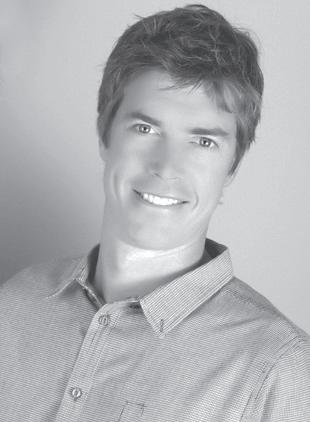
NEW SUMMER

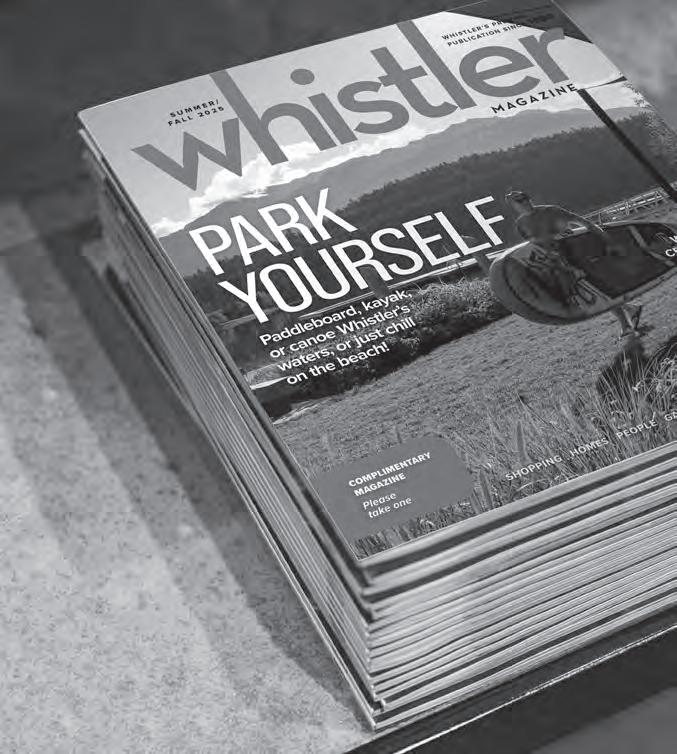
ARTS SCENE
PIQUE’S GUIDE TO LOCAL EVENTS & NIGHTLIFE
Here’s a quick look at some events happening in Whistler this week and beyond. FIND MORE LOCAL EVENT LISTINGS (and submit your own for free!) at piquenewsmagazine.com/local-events

DISCOVER LUGE
UNDERGROUND COMEDY PRESENTS LUKE NULL & FRIENDS
Luke Null is a comedian, actor, and musician known for his sharp wit and musical comedy. A featured cast member on Saturday Night Live, he now tours across the U.S. and is a regular at the Hollywood Improv. Luke will be joined by comedians from the Underground Comedy Club roster for a night of big laughs and bold talent.
> Nov. 7, 7 p.m.
> Maury Young Arts Centre
ADVANCED STOPMOTION WORKSHOP
In this hands-on workshop, young animators learn the art of lip-syncing. Participants will explore how to plan out mouth shapes and animate frame-by-frame to bring characters to life with realistic speech and expression.
> Nov. 8, 10 a.m.
> Audain Art Museum
OUT OF THE ORDINARY TEAM MOVIE
Longhorn Saloon hosts Out of the Ordinary, the newest HEAD and Tyrolia team film. Fresh for 2025, it’s a wild mix of tribute, chaos, and pure ski passion, capturing the HEAD crew’s lodge antics, backcountry missions, and powder-chasing adventures from the Arlberg to B.C. Featuring Freeride World Tour champs, backcountry icons, and Canadian stars Evan McEachran, Cole Richardson, and Meg Cumming, this film celebrates the beautiful madness of life on snow.
> Nov. 9, 6 to 10 p.m.
> Longhorn Saloon
PAINT & SIP WITH CASSIE DICKINSON
Spend a relaxed evening with friends painting beautiful Whistler landscapes, guided by local artist Cassie Dickinson. For just $42, you’ll receive all the painting supplies you need along with a glass of wine to enjoy as you create. All artistic abilities are welcome.
> Nov. 9, 7 p.m.
> The Point Artist-Run Centre
DISCOVER LUGE
Children and youth can now try the Olympic winter sport of luge by sliding down a portion of the track on their own sled. Parents are welcome to spectate, or slide too if space permits. Athletes will receive coaching and be supervised to ensure safety at the venue. Runs rain, snow or shine! No experience required. Youth ages eight to 14.
> Nov. 9
> Whistler Sliding Centre
TEEN ART COLLECTIVE
A safe, supportive space for teens to explore their thoughts and emotions through creative expression. Guided by a trained art therapist, classes encourage self-awareness, emotional growth and personal insight using a variety of art materials and techniques. Whether coping with anxiety, stress, self-esteem issues, or simply seeking a creative outlet, this class empowers teens to use art as a tool for healing, growth, and self-discovery.
> Nov. 10, 4 p.m.
> Audain Art Museum
FEARLESS
Feeling anxious, awkward, and scared in social situations doesn’t mean you’re broken, it means you’re human. A Laugh Out LIVE! five-week workshop series, FearLess is a gentle, laughter-filled space designed to help you ease that inner tension, manage self-doubt, and (re)build your confidence around others. Through the playful tools of applied improv, you’ll learn how to quiet (and temper) that self-critical voice and (re) connect, one moment at a time.
> Nov. 12, 7:15 p.m.
> Westin Resort and Spa
FREERIDE FILM TOUR BY PANGEA COLLECTIVE
The Freeride Film Tour brings this year’s best new ski and snowboard films to the big screen, featuring world-class athletes, stunning backcountry lines, and powerful stories from the mountains. More than a screening, it’s an evening that celebrates the people and places that define freeride. Expect an unforgettable night of films, gear giveaways, and a chance to connect with the people who live and breathe this sport.
> Nov. 13, 7:30 p.m.
> Maury Young Arts Centre
FILE PHOTO BY MICHAEL KRISTEN/FIL

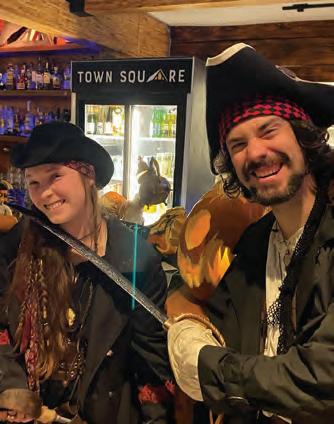
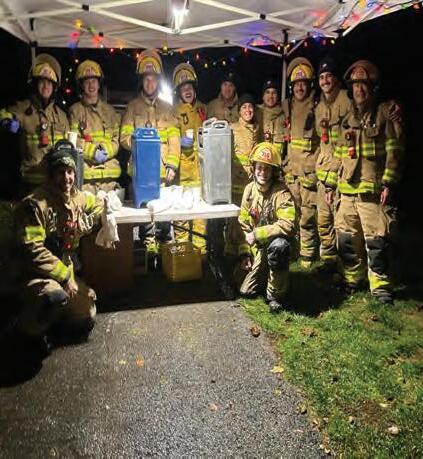






MUSEUM MUSINGS & ASTROLOGY
Interpreting Whistler
BY BRADLEY NICHOLS
WHEN TRAVELLING to a new place, or even exploring your own town, interpretive panels are a great way to learn about local history, wildlife, and the natural environment. These little pop-ups of information can feel a bit like VH1’s Pop-Up Video from the 2000s, which offered quick, engaging insights that added depth and context to a song or music video, much like how interpretive panels help you better understand your surroundings or see a familiar place in a new light.
Over the Whistler Museum’s 38-year history, we’ve had the opportunity to help develop many of the interpretive panels throughout the Whistler Valley. Most recently, we’ve been involved in the creation of the panels that have appeared along the Valley Trail network and throughout the Village starting in 2018, in collaboration with the Resort Municipality of Whistler. These installations have become a wonderful way to share Whistler’s stories in the very places where they unfolded, such as the history panels in Rainbow Park.
Beyond traditional panels, newer forms of interpretation have used technology to share stories in different ways. A great example is the Squamish Lil’wat Cultural Centre’s
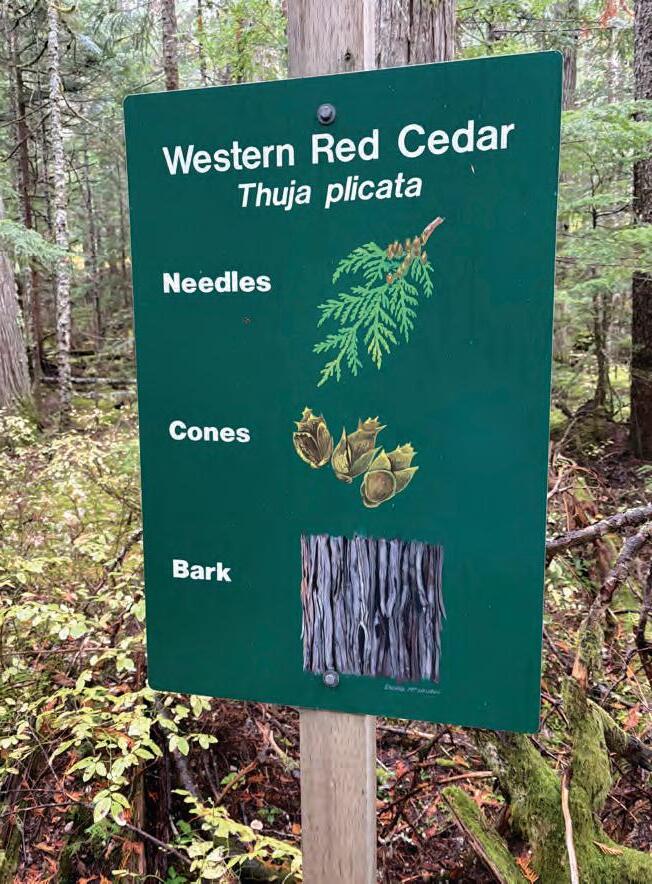
PANEL DISCUSSION One of Isobel’s handpainted signs on the Riparian Trail in the Whistler Interpretive Forest.
PHOTO COURTESY OF THE WHISTLER MUSEUM
Cultural Journey, a self-guided audio tour and series of kiosks along the Sea to Sky highway. Developed in 2010, it weaves together oral histories, traditional place names, and cultural knowledge from the Líl’wat Nation and the Sk_wx_wú7mesh Nation. By pairing the
Free Will Astrology WEEK
ARIES (March 21-April 19): In 1995, wolves were reintroduced to the American wildlife area known as Yellowstone Park after a 70-year absence. They hunted elk, which changed elk behaviour, which changed vegetation patterns, which stabilized riverbanks, which altered the course of the Lamar River and its tributaries. The wolves changed the rivers! This phenomenon is called a trophic cascade: one species reorganizing an entire ecosystem through a web of indirect effects. For the foreseeable future, Aries, you will be a trophic cascade, too. Your choices will create many ripples beyond your personal sphere. I hope you wield your influence with maximum integrity.
TAURUS (April 20-May 20): I authorize you to explore the mysteries of sacred laziness. It’s your right and duty to engage in intense relaxing, unwinding, and detoxifying. Proceed on the theory that rest is not the absence of productivity but a different kind of production—the cultivation of dreams, the composting of experience, and the slow fermentation of insight. What if your worth isn’t always measured by your output? What if being less active for a while is essential to your beautiful success in the future?
GEMINI (May 21-June 20): You are not yet who you will become. Your current struggle has not yet generated its full wisdom. Your confusion hasn’t fully clarified into purpose. The mess hasn’t composted into soil. The ending that looms hasn’t revealed the beginning it portends. In sum, Gemini, you are far from done. The story isn’t over. The verdict isn’t in. You haven’t met everyone who will love you and help you. You haven’t become delightfully impossible in all the ways you will eventually become delightfully impossible.
CANCER (June 21-July 22): By the time he became an elder, Cancerian artist David Hockney had enjoyed a long and brilliant career as a painter, primarily applying paint to canvases. Then, at age 72, he made a radical departure,
region’s views with first-hand stories, it turns the drive between Squamish and Whistler into a richer cultural experience. More information about the tour can be found here: slcc.ca/ cultural-journey.
Whistler’s first interpretive panels date back to 1987. Created by accomplished artist Isobel MacLaurin for the Whistler Rotary Club, these early works depicted Whistler’s landscapes, flora, and fauna. While simple in
ecological and community value, Don worked with BC Parks to ensure the area was protected for public use, a vision that continues to benefit residents and visitors today.
Don also helped establish the Whistler Interpretive Forest in the Cheakamus area during the late 1980s and 1990s. With Isobel’s distinctive artwork, the pair developed and installed interpretive signage throughout the forest. Some of these original hand-painted
While simple in scope, mostly identifying local species, they set the foundation for what would become a long tradition...
scope, mostly identifying local species, they set the foundation for what would become a long tradition of place-based interpretation in the valley.
Isobel and her husband Don MacLaurin moved to Whistler in 1961. Don, a forester and educator at BCIT, was instrumental in preserving several of Whistler’s cherished recreational areas, including Lost Lake Park. When timber licenses in the area were set to expire, developers were poised to move in. Recognizing its
panels can still be found along the Riparian Trail, which was later updated and expanded with support from the Whistler Rotary Club in 2018.
At the Whistler Museum, we continue to enjoy contributing to interpretive panels throughout the valley. Each panel is a chance to build on the work started by the MacLaurins and the Rotary Club, helping residents and visitors alike deepen their understanding of this place and the stories that shape it. n
OF NOVEMBER 7
generating artworks using iPhones and iPads. He loved how these digital media allowed him to instantly capture fleeting moments of beauty. His success with this alternate form of expression has been as great as his previous work. I encourage you to be as daring and innovative as Hockney. Your imaginative energy and creative powers are peaking. Take full advantage!
LEO (July 23-Aug. 22): In his “Letter from Birmingham Jail,” Black activist Martin Luther King Jr. wrote, “We are caught in an inescapable network of mutuality, tied in a single garment of destiny. Whatever affects one directly, affects all indirectly.” He was proclaiming a universal truth: Real courage is never just about personal glory. It’s about using your fire to help and illuminate others. You Leos are made to do this: to be bold not just for your own sake, but as a source of strength for your community. Your charisma and creativity can be precious resources for all those whose lives you touch. In the coming weeks, how will you wield them for mutual uplift?
VIRGO (Aug. 23-Sept. 22): Who would have predicted that the first woman to climb Mount Everest would have three planets in Virgo? Japanese mountaineer Junko Tabei did it in 1975. To what did she attribute her success? She described herself not as fearless, but as “a person who never gives up.” I will note another key character trait: rebellious willfulness. In her time, women were discouraged from the sport. They were regarded as too fragile and impractical for rugged ascents. She defied all that. Let’s make her your inspirational role model, Virgo. Be persistent, resolute, indefatigable, and, if necessary, renegade.
LIBRA (Sept. 23-Oct. 22): Among the Mbuti people of the Congo, there’s no word for “thank you.” Gratitude is so foundational to their culture that it requires no special acknowledgment. It’s not singled out in moments of politeness; it’s a sweet ambient presence in the daily flux. I invite you to live like that for now, Libra. Practice feeling reverence and respect for every little thing that makes
BY ROB BREZSNY
your life such an amazing gift. Feel your appreciation humming through ordinary moments like background music. I guarantee you that this experiment will boost the flow of gratitude-worthy experiences in your direction.
SCORPIO (Oct. 23-Nov. 21): Martin Luther King Jr. said that harnessing our pain and transforming it into wise love can change the world for the better. More than any other sign, Scorpio, you understand this mystery: how descent can lead to renewal, how darkness can awaken brilliance. It’s one of your birthrights to embody King’s militant tenderness: to take what has wounded you, alchemize it, and make it into a force that heals others as well as yourself. You have the natural power to demonstrate that vulnerability and ferocity can coexist, that forgiveness can live alongside uncompromising truth. When you transmute your shadows into offerings of power, you confirm King’s conviction that “the arc of the moral universe is long, but it bends toward justice.”
SAGITTARIUS (Nov. 22-Dec. 21): Apophenia is the tendency to perceive meaningful patterns in seemingly random data. On the downside, it may cause a belief in delusional conspiracy theories. But it can also be a generator of life’s poetry, leading us to see faces in clouds, hear fateful messages in static, and find key revelations in a horoscope. Psychologist C.G. Jung articulated another positive variation of the phenomenon. His concept of synchronicity refers to the occurrence of meaningful coincidences between internal psychological states and external events that feel deeply significant and even astounding to the person experiencing them. Synchronicities suggest there’s a mysterious underlying order in the universe, linking mind and matter in nonrational ways. In the coming weeks, Sagittarius, I suspect you will experience a slew of synchronicities and the good kind of apophenia.
CAPRICORN (Dec. 22-Jan. 19): Philosopher Alfred Korzybski coined the phrase “the map is not the
territory.” In other words, your concepts about reality are not reality itself. Your idea of love is not love. Your theory about who you are is not who you are. It’s true that many maps are useful fictions. But when you forget they’re fiction, you’re lost even when you think you know where you are. Here’s the good news, Capricorn: In the weeks ahead, you are poised to see and understand the world exactly as it is—maybe more than ever before. Lean into this awesome opportunity.
AQUARIUS (Jan. 20-Feb. 18): Babies are born with about 300 bones, but adults have 206. Many of our first bones fuse with others. From one perspective, then, we begin our lives abundant with possibility and rich with redundancy. Then we solidify, becoming structurally sound but less flexible. Aging is a process of strategic sacrifice, necessary but not without loss. Please meditate on these facts as a metaphor for the decisions you face. The question isn’t whether to ripen and mature—that’s a given—but which growth will serve you and which will diminish you.
PISCES (Feb. 19-March 20): Beneath every thriving forest lies a lacework of mycelium. Through it, tree roots trade nourishment, warn each other of drought or illness, and make sure that young shoots benefit from elders’ reserves. Scientists call it the “wood-wide web.” Indigenous traditions have long understood the principle: Life flourishes when a vast communication network operates below the surface to foster care and collaboration. Take your cues from these themes, Pisces. Tend creatively to the web of connections that joins you to friends, collaborators, and kindred spirits. Proceed with the faith that generosity multiplies pathways and invites good fortune to circulate freely. Offer what you can, knowing that the cycle of giving will find its way back to you.
Homework: What attachment would be healthy to relinquish? Newsletter.FreeWillAstrology.com.

ÚlÍusCommunityCentre
•Custodian/EventsHost($17.85-$20.90perhour)
•Custodian($17.85-$20.90perhour)
•HumanResourcesGeneralist($57,330.00to$64,610.00peryear)
•AdministrativeAssistant($38,038.00to$53,599.00peryear)
•DirectorofTitleandRights($93,475.20to$101,556.00peryear)
Child&FamilyServices
•AssistantDirector,Child&FamilyServices($93,475.00to $101,556.00peryear)
Lil’watHealth&Healing+PqusnalhcwHealthCentre
•HealthProjectManager($57,330.00to$64,610.00peryear)
•HealingProgramManager($57,330.00to$64,610.00peryear)
•CommunityHealthNurse($41.42to52.81perhour)+$2.15 hourlypremium)
•Registered/LicensedPracticalNurse-HomeCare($32.84to $45.03perhour+$2.15hourlypremium)
•LicensedPracticalNurse(LPN)-ChronicDisease($32.84to $37.81perhour+$2.15hourlypremium)
CommunityProgram
•EarlyChildhoodEducator-Infant Toddler($24.00-$29.45/hr basedonexperience+thispositioniseligibleforwagetopup)
Xet’òlacwCommunitySchool
•LanguageResource WorkerorLanguage Teacher($46,683to $109,520peryear)
•ElementarySchool Teacher($65,823.00to$109,520.00peryear)
Pleasevisitourcareerpageformoreinformation:https://lilwat.ca/careers/
WHAT’S ON YOUR
CAREEROPPORTUNITIES
Love agoodchallenge?Passionate abouttheplaceyoucallhome? Tourism Whistlerislooking forcommunity-loving, mountain-appreciating,environmentrespectingpeopletojoinourteam.Come collaboratewithus. We’rehiring forthe followingopportunities:
•Specialist,Email Marketing (Full Time, Year Round).Startingsalary rangeis$55,000 -$59,000annually.
•Manager,DataMarketing &Analytics (Full Time,Contract).Startingsalary rangeis$60,000 -$68,000annually.
WhatWeOffer:
•Fortnightscheduledesignedto enhance work-life balance
•Comprehensivebenefitspackage
•Whistler-basedwith ahybrid approachthatbalancesbothin-office and remote work
•A funandsupportiveteam environment
•Commitmenttoemployee well-being, health,andsafety
TO VIEWOURCAREEROPPORTUNITIES, AND TO APPLY, VISITUSONLINE AT: WHISTLER.COM/CAREERS.









BUILDINGOURCOMMUNITY




EmployeeHealth &WellnessPlanavailable
HEAVYEQUIPMENTOPERATOR– Minimum 5yearsor5,000hoursoperatingexperience onexcavator.Full-time,Monday –Friday. $33-$46perhour.
CONSTRUCTIONLABOURER– Greatopportunitytolear non-the-job.Staminaforphysically demandingworkandperseverancetobraveinclementweather required. Previousexperiencepreferredbutnot required. Trainingprovided.$28-$33perhour.
PIPELAYER –Minimum 5yearsexperienceincivilconstruction. Full-time,Monday –Friday.$33-$43perhour.
TRUCKDRIVER –BCDLClass 1orClass 3withairbrakes required.Manualtransmission. 2yearsexperiencepreferred.$35-$41.50perhour.
PROJECTMANAGER –Minimum10yearsexperiencepreferred.CivilEngineeringdegreeor CivilTechnologydiplomapreferred.Full Time,$90,000to$125,000peryeardependingon experienceandqualification.
ACCOUNTANT –Preparefinancialinformation,statements, reportsanddevelopinternal controlprocedures.CPAorworkingtowardsdesignationpreferred.$28-$34perhour.

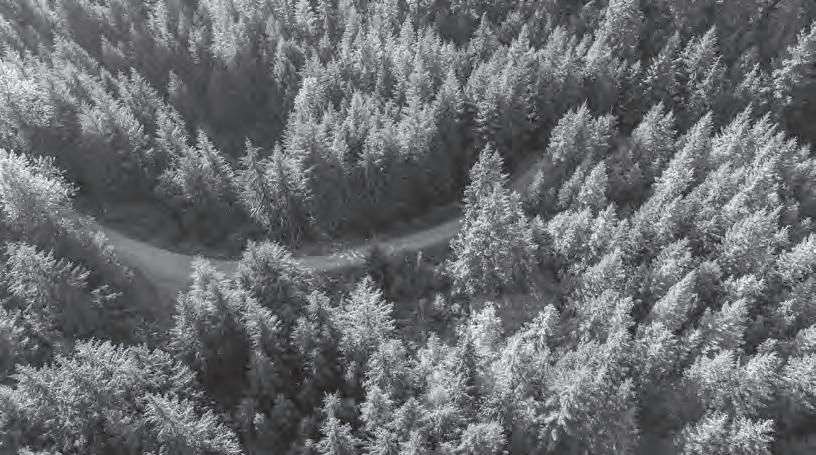
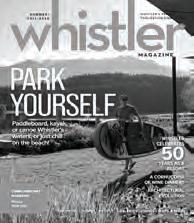





-atMekongRestaurantinCreekside -Deadlineforregistration:November14th
-Cost: $1299

GroupFitnessClasses
Friday
I7:30-8:30a.m.StrengthinPlay–Anna Saturday
I10:30-11:30a.m.Zumba–Jane Monday
F6-7p.m.SPIN–Courtney Tuesday
I5:30-6:30a.m.TRXMixer–M-A Wednesday
F6:00-7:00p.m.SPIN–Courtney Thursday
F5:15-6:15p.m. Yoga:CoreFusion–Heidi



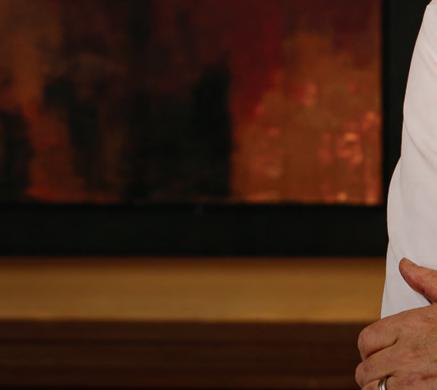

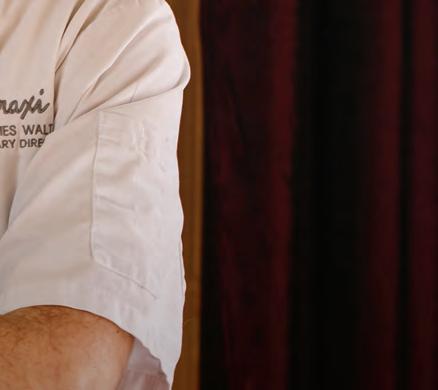

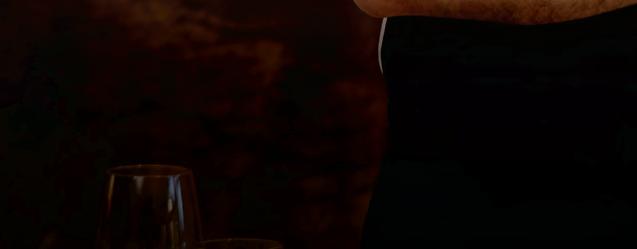















JOBOPPORTUNITIESINTHE
SSHSHEALTHPROGRAM
Programoverview:

TheHealthprogramteamwillworktogethertoprovidecaretocommunitymembersof three(3)remote FirstNationcommunitiesbybeingresponsibleforfullscopenursing careto avarietyof clients,constantlypromotinghealthandwellnesseducation,and aligningcareoutofcommunityinsomecases,providingcaretohomecareclientsand memberswithchronicdiseases,constantlypromotinghealthandwellnesseducation, andaligningcareoutofcommunity.
Open Positions:
1.ClinicalServicesManager($90000 -$120000)
2.HomeandCommunityCareNurse($90000- $110000)
3.CommunityHealthNurse($90000 -$110000)
Eachpositionrequiresa minimumofthefollowingQualifications:
•Bachelor’sDegreeinNursingfrom arecognizeduniversity
•5+yearsnursingexperienceincluding:
O Publichealth(maternal,infant,child,youth,mentalwellness,addictions)
O Homecare(elderhealth,chronicdiseasemanagement,injury prevention)
•CurrentCPR(HCP)certification
•Currentpracticingregistrationas aRegisteredNursewiththeBCCollegeof NursesandMidwives(BCCNM) furtherqualificationsmayberequiredbasedontheposition
Special:
•ThesepositionsrequiretravelingtoindigenouscommunitiesservedbySSHS, accessedbyForestServiceRoad
•SSHSoffers acompetitivebenefitsandemploymentpackagetofulltime employees
AboutSSHS:
SSHSisa non-profitIndigenoushealthorganizationdedicatedtoimprovingthehealth andwell-beingofIndigenouscommunities.Ourorganizationprovidesculturally appropriatehealthcareservices,programs,andinitiativestosupporttheholistichealth ofIndigenousindividualsandfamilies.
Seefulljobpostings: sshs.ca/careers/

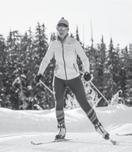




ApplicantsmustpossessaNursingdiplomaordegree, currentpracticingregistrationwithBCNU,a class5 driver’slicenseanda clearcriminalrecordcheck, includingvulnerablesector.
Formoredetailsonthejob,orto applyvisit www.lilwat.ca/careers
Foranyquestionsemail: hr@lilwat.ca


$22/hour
F/T&P/Thoursavailable **nostaffaccommodationavailable** MustbeavailableFriday,Saturday&Sundays
FrontDeskdutiesincludeproviding resort information&directions,providing informationaboutthelodge. Additionallodgedutiesincludeprearrival& postdeparturecheckofvacation rentalunits: thisincludeschanginglightbulbs, troubleshootingWIFIorcabletvwithinunits, unloadingtheoccasionaldishwasheror wipingdownacountertopifneeded. We arelookingforsomeonewhohas attentiondetail,isabletoworkindependently, cancommunicateclearly,isaproblem-solver, willingtouseacomputerand canselfleadcompletingdailytasks.
resumesto: info@acervacations.com
SouthernStl'atl'imx HealthSociety
WhereSkwxwú7meshandLílwat7úl culturesmeet, growandareshared.
PEOPLEOPER ATIONSCOORDINATOR
Part-Time —3 days/week
SALES MANAGER
WeddingsandCorporate
Wearelooking foracaring,organizedteammemberwhobrings strongadministrationskillsand apassion forsupportingothersat theSquamishLil’watCulturalCentreinWhistler.
This roleblendsHuman Resourcessupport,cultural connection,and operational coordination —helpingensureeachteammember feels welcomed,informed,andset up forsuccess.
Weoffer:
•Extendedhealthbenefits
•RRSPmatching
•WhistlerBlackcombseason passorwellnessspendingaccount
•Training &educationallowance
•Asupportive team rootedinIndigenouscultureand community

Come buildandgrow withthebestteam.
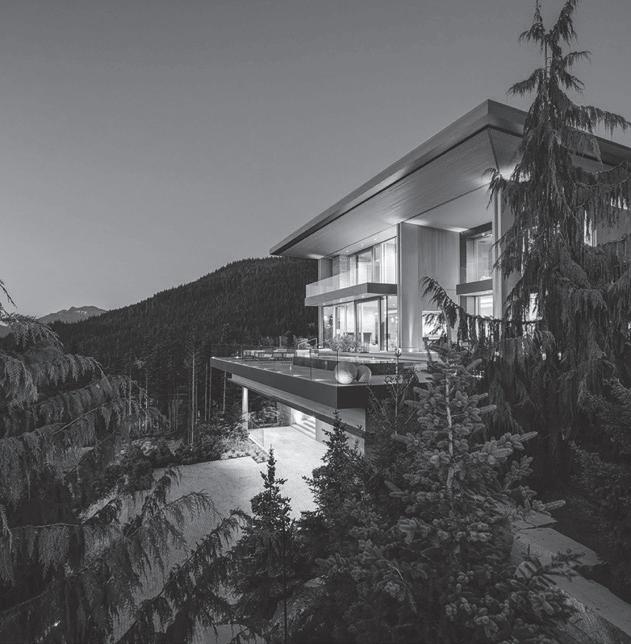
Ourteamofpeopleis whatsetsusapartfromotherbuilders.As wecontinue to growasthe leaderinluxury projectsinWhistler,ourteamneeds to expand withus.
We are currentlyhiring:
Labourers ($20-$30hourly)
CarpentersHelpers/Apprentices1st to 4th year ($25-$35hourly)
ExperiencedCarpenters ($30-$45hourly)
Carpentry Foremen ($40-$50hourly)
SiteSupervisor
Learnmoreandapplyat slcc.ca/careers
Startingat$25/hour, 25/hour, basedonexperience.

Learnmore andapplyatarnmoreandappl slcc.ca/careers
CAR eerpAT h CA rVe Ou T ANEW
CAREEROPPORTUNITIES
Love agoodchallenge?Passionate abouttheplaceyoucallhome?Tourism Whistlerislooking forcommunity-loving, mountain-appreciating,environmentrespectingpeopletojoinourteam.Come collaboratewithus. We’rehiring forthe followingopportunities:
•Specialist,Web Marketing &Sales (Full Time,Contract).Startingsalary rangeis$55,000 -$59,000annually.
•Manager,Sales Operations (Full Time,Contract).Startingsalary range is$60,000 -$68,000annually
WhatWeOffer:
•Fortnightscheduledesignedto enhance work-life balance
•Comprehensivebenefitspackage
•A funandsupportiveteam environment
•Commitmenttoemployee well-being, health,andsafety
TO VIEWOURCAREEROPPORTUNITIES, ANDTOAPPLY, VISITUSONLINE AT: WHISTLER.COM/CAREERS.


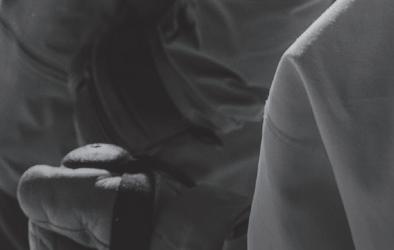

Rates vary basedonexperience andqualifications.RedSealisabonusbutnot required.Crane Operatorexperienceconsideredanasset.
EV R is commit te d to th e long-t er m re tent io n an d sk ills deve lopm en t ofou
passionateaboutinvestinginourteam’s future
WE OFFER:
• Top Wagesanda Positive WorkEnvironment
•FlexibleSchedule- WorkLife Balance (Wegetit, we love to skiandbike too.)
• Training& TuitionReimbursement(Needhelpgetting yourRedSeal?)
•Support with workvisaand PermanentResidency (We canassist)
BENEFITS &PERKS:
• AnnualLeisure& ToolBenefit – Use toward ski/bike pass, toolpurchase, etc. – you choose!
•ExtendedHealthandDentalBenefitsfor youand yourfamily
We promotefrom withinandarelooking to strengthenouramazingteam.Opportunitiesfor advancementinto managementpositionsalwaysexistfortheright candidates.Don’t missout onbeingable to build withtheteamthatbuildsthe mostsignificantprojectsinWhistler. Send your resume to careers@evrfinehomes.com. We lookforward to hearingfrom you!





















Where the wild things weren’t
A FEW WEEKS AGO , I was sitting around after Thanksgiving dinner, uncomfortably full, catching up with friends I hadn’t seen in far too long. As often seems to happen these days, I found myself in a conversation that started, “have you seen what AI can do now?!”

BY LIZI MCLOUGHLIN
We watched an AI actress—Tilly Norwood—star in an AI-generated comedy sketch with a host of AI supporting characters. The company that created the sketch pitches itself as “the future of production,” and its website also showcases life-like historical recreations, VFX, and cinematic landscape videography.
A few days later, curious, I found myself watching a “cinematic nature montage” produced by the same company. The dramatic close-up of an AI bear was, to my eyes, indistinguishable from an actual bear. And, set to an evocative soundtrack, the sweeping desert vistas and soaring peaks almost stir up the same emotions as a David Attenborough documentary.
Except that, underneath the familiar sense of wonder, these unnatural images of nature make me feel… sad. I can’t help thinking that someone could have flown to Northern B.C. and spent days in the forest trying to catch a glimpse of that bear. Or had the adventure of a lifetime hunting out the perfect desert sunset shot. When did we decide we wanted AI to do our sightseeing for us?
The creative potential of AI is an enormous part of its irresistible appeal. And it makes sense: for many of us, AI can translate our imagination into reality far better than any tool or technology we’ve ever had access to. Whether helping us write professional emails, plan a kitchen renovation, or create a video of a dancing dog, AI has unlocked access to creativity in a way we haven’t felt before.
choosing outcome over process, convenience over experience, certainty over discovery. There’s an argument for that, and in an increasingly isolating, unpredictable world, it’s not surprising we’re drawn to tools that promise quick, predictable results.
But as we make these choices, it’s easy to forget what we’re not choosing. The chance to go out for a drink with someone cute instead of getting AI to chat to your Tinder matches for you. The chance to call a friend for advice instead of getting guidance from ChatGPT. The chance to capture the moment the sun rises over the mountains.
Of course, there’s no guarantee any of those things will turn out the way we hope— that’s kind of the point. Doing things in the real world requires effort, risk, uncertainty,
I think we’re drawn to ChatGPT because it’s more like a human than any technology that came before it.
But it feels like our naive curiosity can easily become self-destructive—especially when we start handing over the things that make us feel most alive to something that can never know what it feels like to be alive.
When we sit behind a computer and make the bears and the sunsets come to us, we’re
discomfort. And frankly, half the time, we feel too tired, uncomfortable, and anxious to willingly choose any more hard things. But doing stuff in the real world also leads to connection, confidence, serendipity, opportunity. It’s scary, sure, but it’s what we’re here for.
The funny thing is: AI doesn’t always guarantee success, either. We’re not drawn to ChatGPT because it always gives us the best outcome. It just gives us an outcome, and most of the time that’s good enough. It’s almost like it has the confidence that we aspire to—it just tries, and when it gets it wrong, it tries again, and again, and along the way it creates both magic and a mess.
I think we’re drawn to ChatGPT because it’s more like a human than any technology that came before it. When it gets it wrong, we just smile and shrug, because we do the same thing all the time. Perhaps we love AI because it’s flawed, just like we are.
Still, I’m fascinated by the idea that, in embracing a technology that is striving to think, talk, and act like a human, we’re choosing to use it to avoid doing the things that make us feel most human. Who would rather sit behind a screen prompting an AI than hire a helicopter to shoot first-hand footage of snowcapped summits?
Which makes me wonder if AI is more of a symptom than a cause of our disconnection. After all, it was made by people, and it evolves because of the way people use it, what we ask of it. If we want AI to do our living for us—to tell our stories, take our photos, solve our problems—it can, and it will. If we want it to make it easier to actually be a human, it can do that too. I know which option I would choose.
Lizi McLoughlin is a local non-profit leader, an average-but-enthusiastic mountain athlete, and an eternal optimist. n
NEWTOMARKET

8409 Big Sky Terrace, Whistler
3 Bed | 2.5 Bath | 3,152 sq.ft.

$4,395,000 604-902-3335
Steve Legge PREC* steve.legge@evrealestate.com
NEWPRICE

3366 Lakeside Road, Whistler
3 Bed | 3 Bath | 2,327 sq.ft.


$3,299,000 604-938-3815
Ron Mitchell PREC* & Rachel Allen ron@resortwhistler.com R&R Group

#12-2213 Marmot Place, Whistler
1 Bed | 1 Bath | 516 sq.ft.


$925,000 604-902-3309 Peter Lalor broker@evwhistler.ca

2026 Garibaldi Way, Squamish
3 Bed | 2 Bath | 1,248 sq.ft

$1,399,000 778-318-5900
Angie Vazquez PREC* angievazquezrealtor@gmail.com Vazquez Realty Group


maggi.thornhill@evrealestate.com
Maggi & Max Thornhill Team


1530 Spring Creek Drive, Spring Creek 4 Bed | 5 Bath | 3,196 sq.ft.
$4,999,000

604-910-1103
Connie Spear connie.spear@evrealestate.com

1005 Phare Crescent, Pemberton 6 Bed | 6 Bath | 2,939 sq.ft
$1,798,000

604-698-5899
Valerie Phillipson valerieaphillipson@gmail.com

